| |||||||
| Search Forums |
| Advanced Search |
| Go to Page... |
 |
| Search this Thread |  405,456 views |
| | #1 |
| Senior - BHPian | Maruti S-Presso : Official Review The Maruti S-Presso is on sale in India at a price of between Rs. 3.71 - 4.99 lakhs (ex-Delhi). What you'll like: • Funky design stands out from the crowd • Well-priced for what it offers • Spacious cabin with enough room for four 6-footers, and easy ingress / egress too • Fantastic engine & MT gearbox. Fun, driveable, revv-happy, fuel efficient • Optional AMT automatic available at a Rs. ~43,000 premium • 180 mm of ground clearance & a tiny 4.5m turning radius aid practicality • Boot has a practical layout. Rear seat does fold down when required • Nice touchscreen ICE with Android Auto + Apple CarPlay + steering mounted controls • Maruti's fuss-free ownership experiences & widespread dealer network What you won't: • 0 stars in the GNCAP crash tests (full discussion) • Controversial styling with oddball proportions – you’ll either love it or hate it • Basic ride quality has a distinctly firm edge to it. Can get bumpy • Terrible highway dynamics & NVH at 100 km/h. Best driven at double-digit speeds • Weird, poorly-calibrated steering has many flaws • AMT, although improved, can’t match conventional ATs on smoothness & speed. Still gets jerky • Narrow width makes it a 4-seater (not 5) • Missing rear power windows, rear defogger & day / night IRVM • Skinny 165 mm tyres or atrocious 145 mm rubber (lower variant). Fuel tank is just 27L in size Last edited by GTO : 13th November 2020 at 14:23. |
| |  (47)
Thanks (47)
Thanks
 |
| The following 47 BHPians Thank blackwasp for this useful post: | 2himanshu, AdityaDeane, ashis89, AYP, Balaji31582, bharatmarch, BoneCollector, bvasista, Chrome6Boy, dailydriver, deepfreak15, digitalnirvana, DrANTO, GTO, hmansari, InControl, landcruiser123, Leoshashi, manij, MDED, mp417, MSAneesh, N33raj, neil.jericho, nmenon, ObsessedByFIAT, Omkar, PearlJam, Punatic, Rajeevraj, RavenAvi, Reinhard, samaspire, Sanidhya mukund, Simhi, smuniswami, SnS_12, sri2012, styx71, suhaas307, The Rationalist, TheARUN, theexperthand, Thermodynamics, vaasu, vb-saan, wheelguy |
| |
| | #2 |
| Senior - BHPian | Review Index: Exterior Last edited by Aditya : 20th February 2020 at 09:22. |
| |  (12)
Thanks (12)
Thanks
 |
| The following 12 BHPians Thank blackwasp for this useful post: | bvasista, deepfreak15, digitalnirvana, GTO, landcruiser123, Leoshashi, NiInJa, RavenAvi, Scorpion 10, suhaas307, theexperthand, vb-saan |
| | #3 |
| Senior - BHPian | Exterior Forget all the talk about “SUV”. Think of the S-Presso as a more practical, tall hatchback instead: 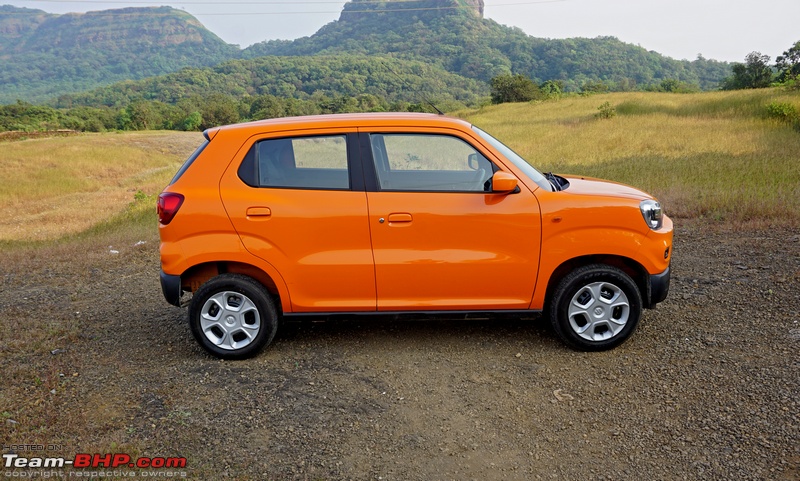 To capitalise on the fascination with tall SUV'ish cars, Maruti has launched the S-Presso, which is a hatchback with a pseudo-SUV appearance. The car is based on the Future S concept, which was unveiled at the 2018 Auto Expo. While the Alto has been the segment leader for a while now, its sales have fallen from a high of 25,000 to 15,000 units a month. The Kwid sells around 5,000 units, while the RediGo does less than 1,000 units every month. This segment is important as it gives a first time buyer an entry into the brand; Maruti knows this well and hence, the S-Presso is an important product for it. Yes, the S-Presso’s styling is very controversial and it has divided opinion on our very own Team-BHP too. While 50% of BHPians love it, the other 50% hate it. This is by design. If Maruti were to launch a neutral looking car - like say the Celerio - in this crowded hatchback segment, it would sink without a trace. Make no mistake, the controversial styling is fully intentional; it is designed to stand out. Boring won't work. There is no doubt that Renault did a far better job with the Kwid / Climber in the styling department though. That said, the S-Presso looks better in person than in pictures. Indians love SUVs of any size, whether they are big or small, or real or fake. Our orange test car turned heads like Jennifer Love Hewitt in a red dress! We were frequently asked about it and could notice the curiosity of other motorists. Like most other cars in the A-segment, the S-Presso is powered only by a petrol engine - a 1.0L, 3-cylinder, BS6-compliant unit. It comes with a choice of a 5-speed manual or an AMT. No CNG version is on offer at the moment, but the company could introduce it in the future - it was showcased at the Auto Expo 2020. The S-Presso has made a good start with 8,000 - 10,000 dispatches a month. Still, its early days yet to pass any judgement on its success. 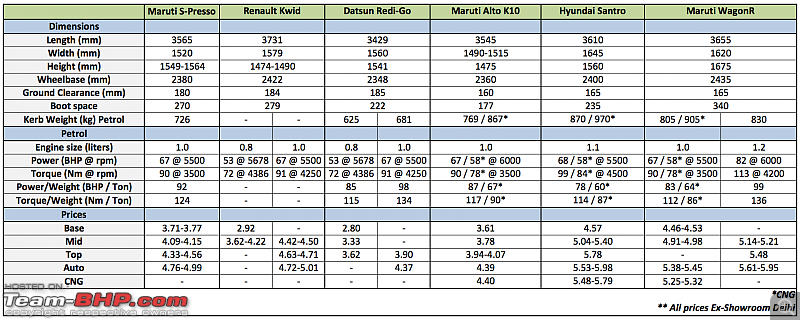 The S-Presso is built on the Heartect platform, which is shared with cars like the WagonR, Ertiga and Baleno. Build quality is typical economy-grade Maruti. It’s not so tinny that too many will complain, but it’s no Hyundai either. The gaps around the bonnet and boot are wider than in other areas, but it's mostly alright. The doors have some weight to them (they don't feel too tinny), while the bonnet is on the lighter side. There is some amount of flex on the front fenders and doors when pressed with a thumb though. The VXi+ variant is equipped with dual airbags, ABS with EBD, speed sensing door locks, seatbelt reminder for the front occupants and reverse parking sensors. Maruti claims that the S-Presso is pedestrian protection-compliant and meets the front and side collision norms. Maruti is offering a standard warranty of 2 years / 40,000 km, which can be extended to 5 years / 1,00,000 km. We always recommend purchasing an extended warranty for added peace of mind. The S-Presso looks more Mahindra than Maruti from the front. The dual-tone bumper with the large black lower portion is attention grabbing. To its credit, the car does look better in person than its (ugly) pictures would suggest. But, it’s no beauty queen at all. Let’s just say it looks “less bad” in person: 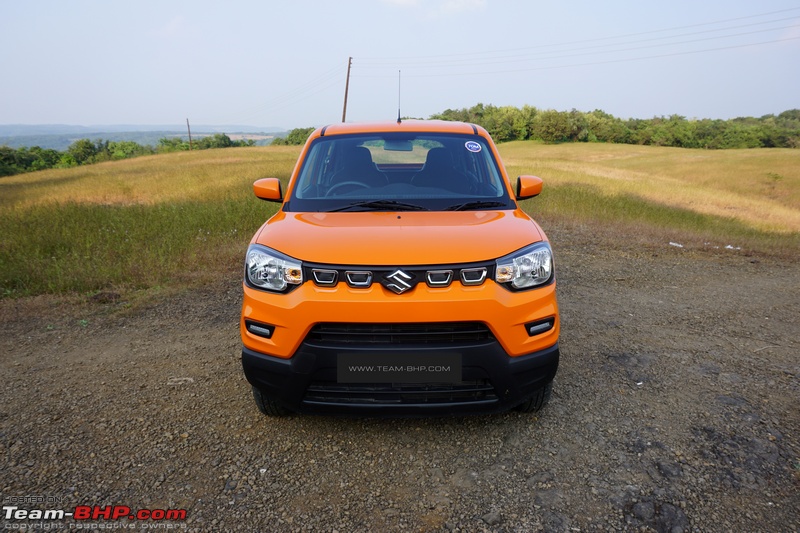 The rear is more acceptable compared to the front. Tail-lamps are modern and the dual-tone bumper stretches all the way up to them. Exhaust pipe can be seen peeking out from below. That said, it would look way better with thicker tyres. Skinny tyres make the S-Presso look like it is standing on stilts, especially when viewed from the rear! The lower variants with their toothpick-thin 145 mm tyres look absolutely atrocious! 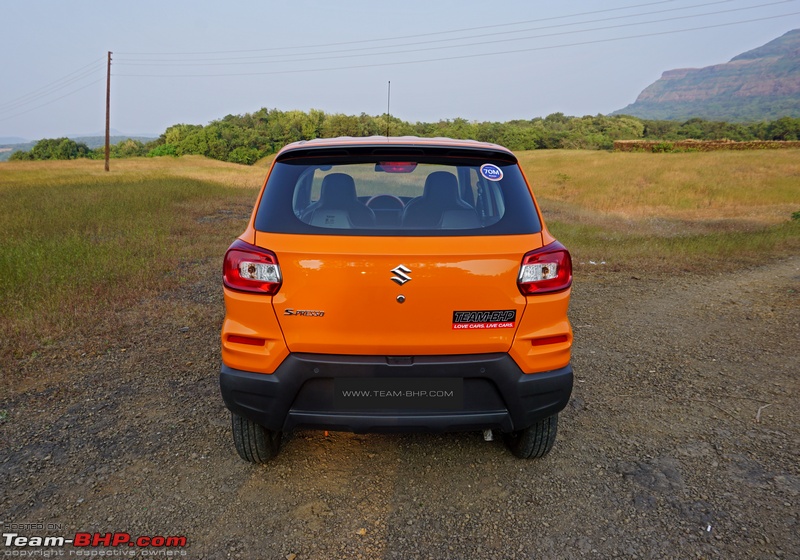 The S-Presso gets flared, squarish (not round) wheel arches to lend some ruggedness to the look and straight character lines running across the doors. Gap between the wheel & arch is way too large. Looks ugly. It’s especially horrible at the rear and the tyre is way off center. Would suggest getting the wheel well coated in black (anti-rust maybe) to improve the looks (or you can buy the car in a darker colour). Customers preferring a clean look will look at the Alto instead: 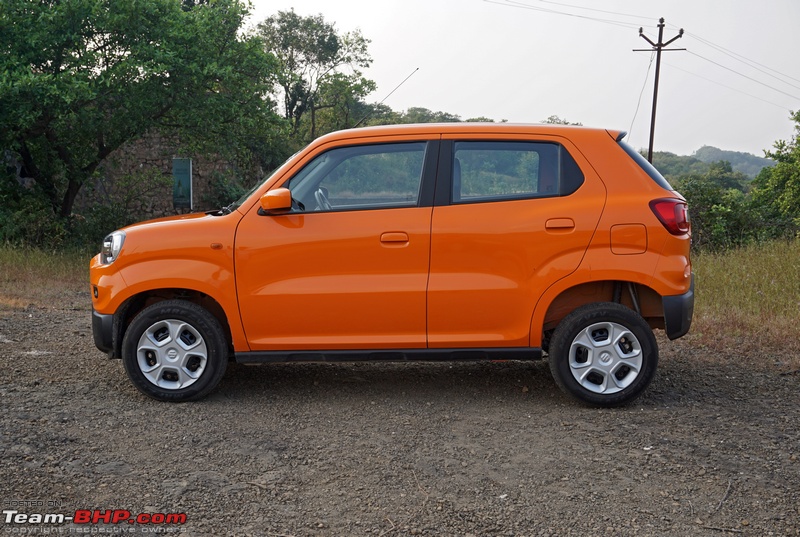 Maruti has definitely made the S-Presso stand out among its rivals. If they had designed it like any other car out in the market, it wouldn't have had any differentiating factor. It measures 3,565 mm in length, 1,520 mm in width and 1,564 mm in height with a wheelbase of 2,380 mm: 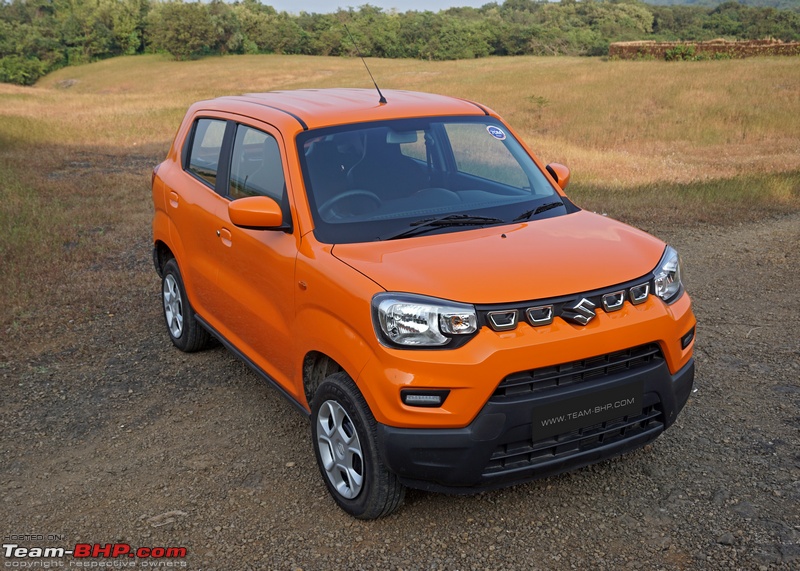 Viewed from the rear three-quarter, observe the continuity of the arch on the rear door and fender, aligning with the reflector bulge and the lower edge of the hatch. This is my favourite view of the S-Presso: 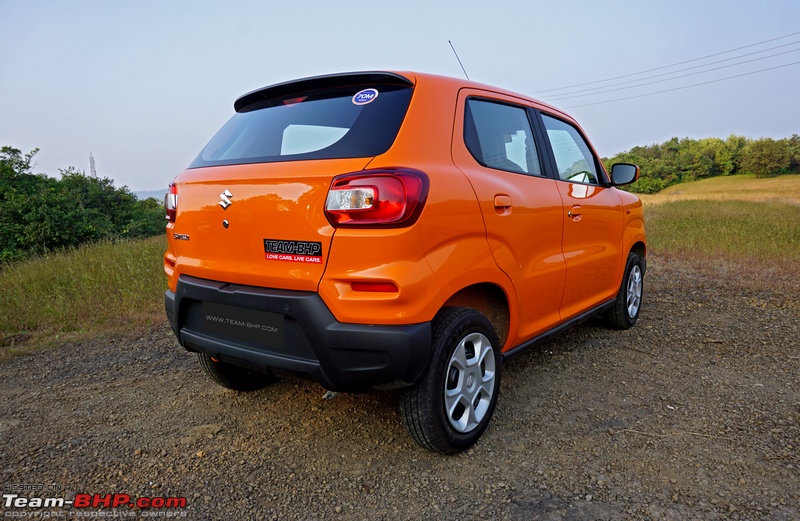 Squarish headlamp tapers on the inside to meet the grille: 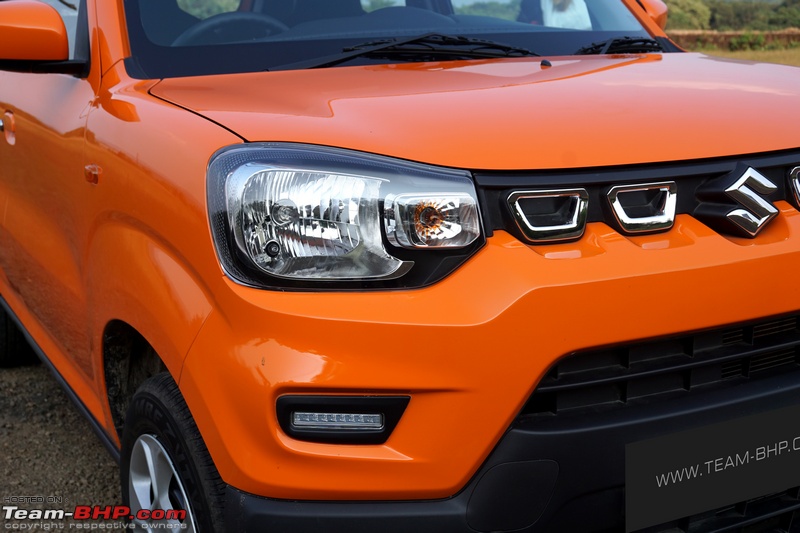 With all the lights in action. There are no follow-me-home or lead me to vehicle functions provided: 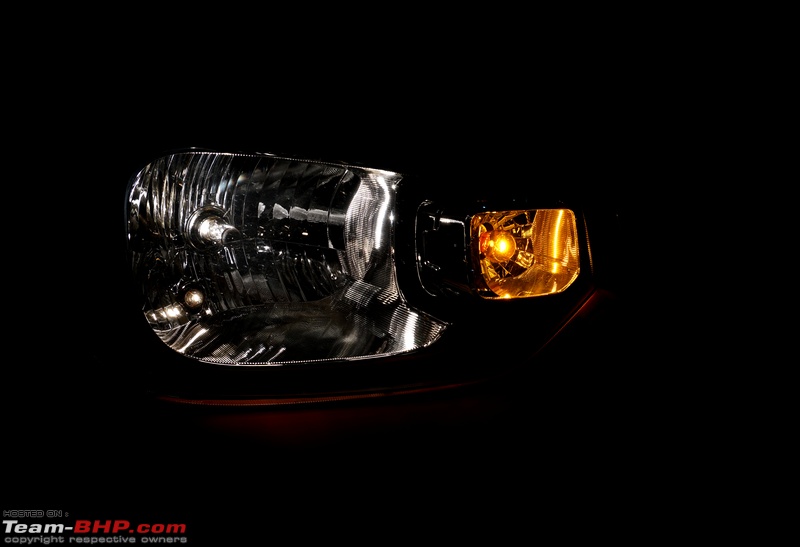 LED DRLs not a part of the standard package, but available as accessories. They are bright and visible in the day. When you turn on the parking lights, they dim a bit and turn off when the headlights are in use: 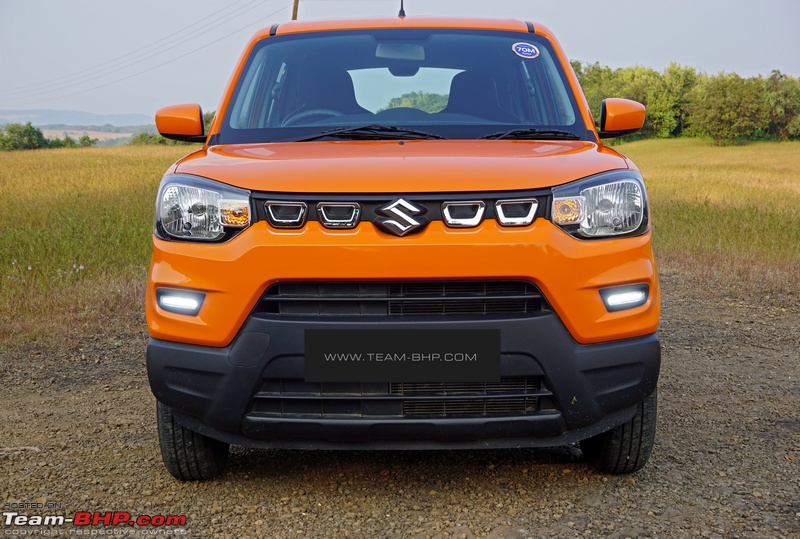 Slim grille gets the S logo in the middle. The trapezoidal chrome bits are part of official accessories. Looks like it is trying to mimic the Jeep grille: 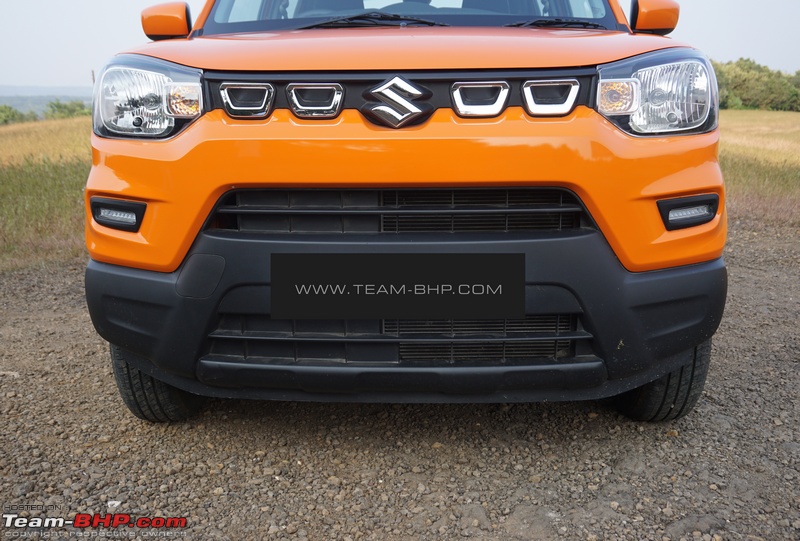 The grille is completely blocked off and the chrome (an aftermarket accessory) appears to be stuck using double side tape. We tried to pull it off and it felt loose:  The dual-tone bumper looks like 2 bumpers stacked one above the other. Only one half of grille is open for air flow. The bumper also gets a wind deflector below. No foglamps, not even as an accessory: 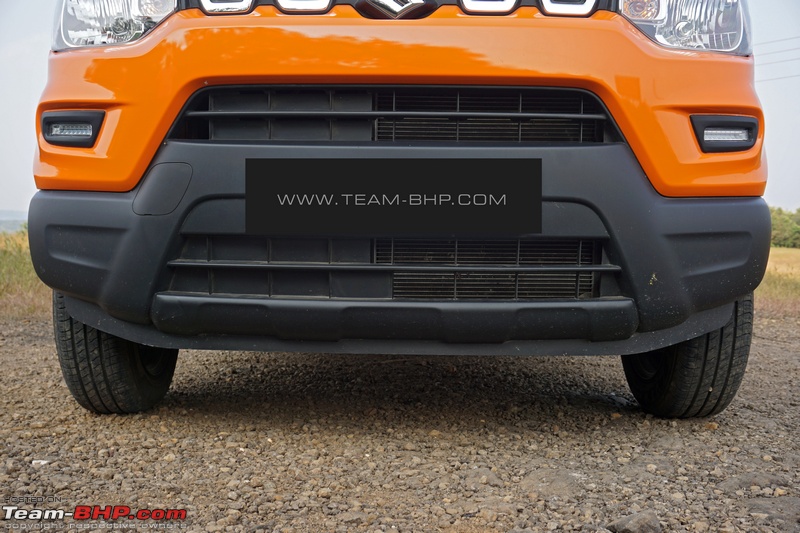 Tow-hook cap is located on the driver side. Also notice the DRL accessory: 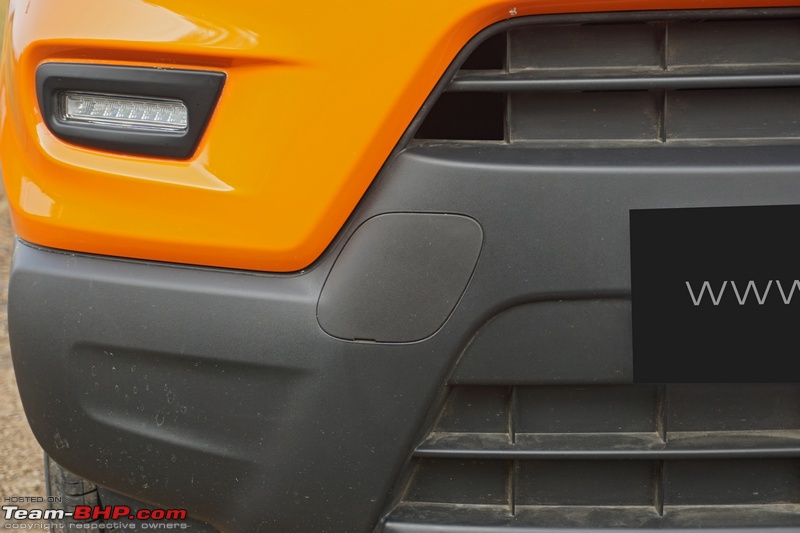 Absolutely no underbody protection at all! Not even a cheap plastic cover below the engine. This is unacceptable for Indian road conditions - Maruti should know better: 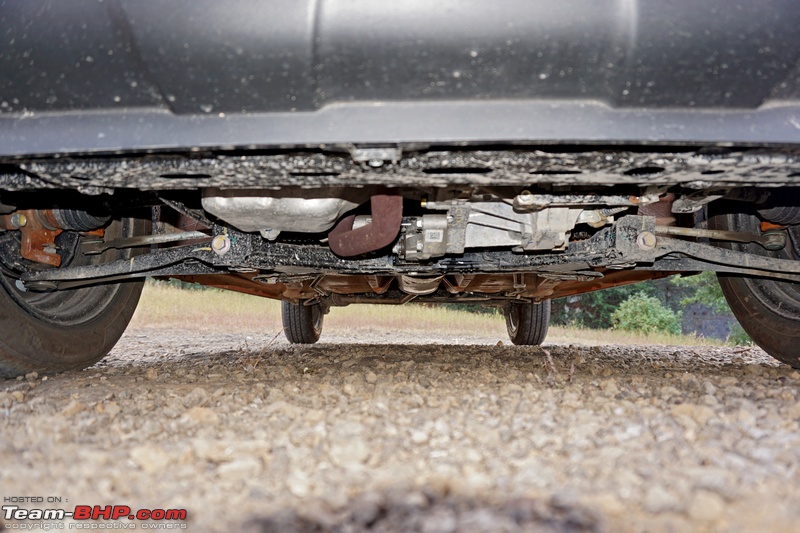 Flat bonnet is devoid of any creases. It gets a single windscreen washer in the center: 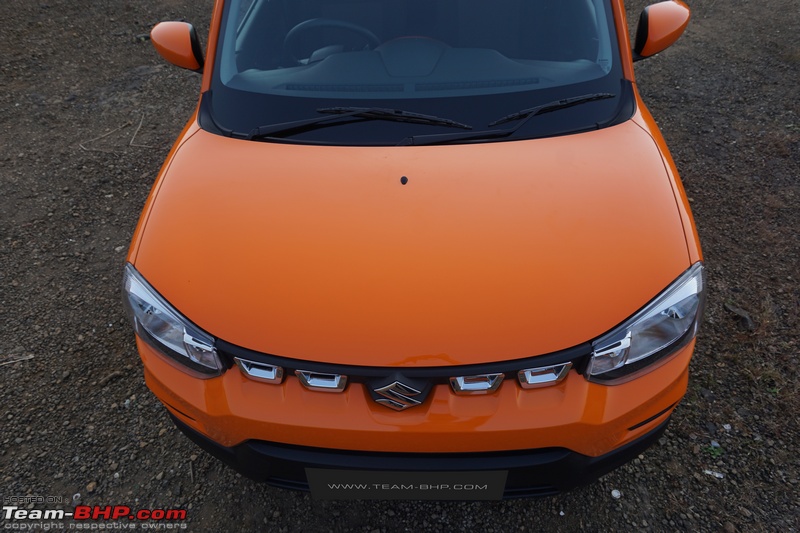 Wiper spindles are not concealed under the bonnet. They stand out: 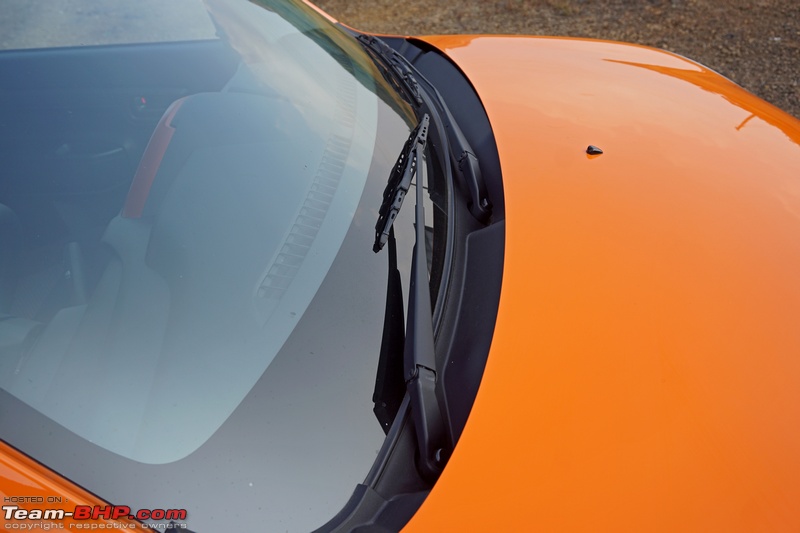 Lone washer nozzle squirts 3 jets of water: 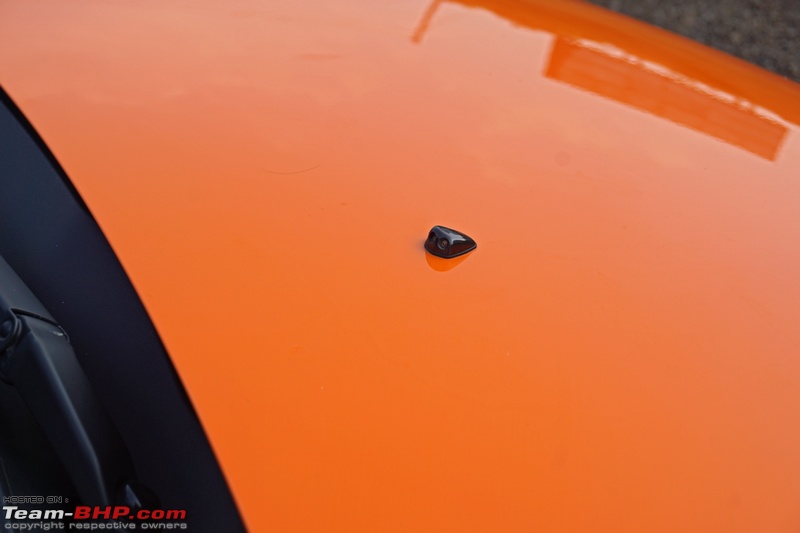 Windshield washer in action. The wipers have a good sweep: 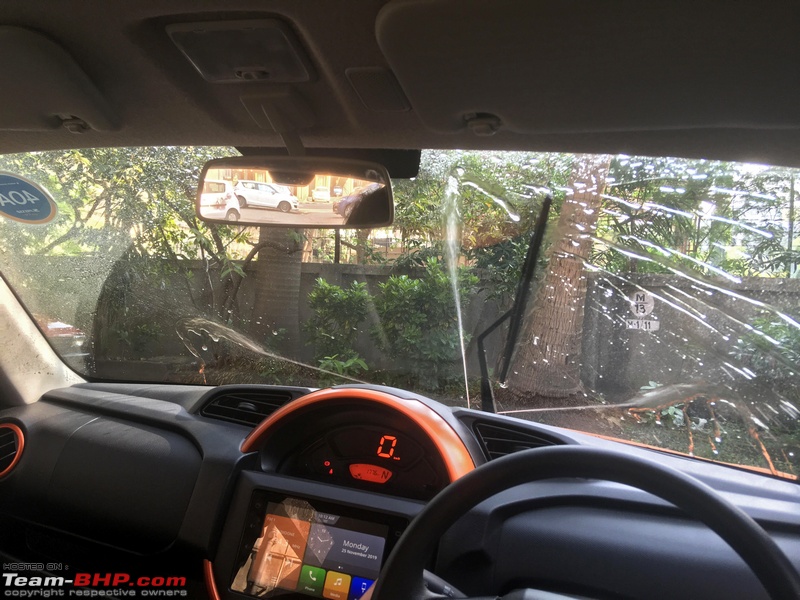 Shut lines around the doors... 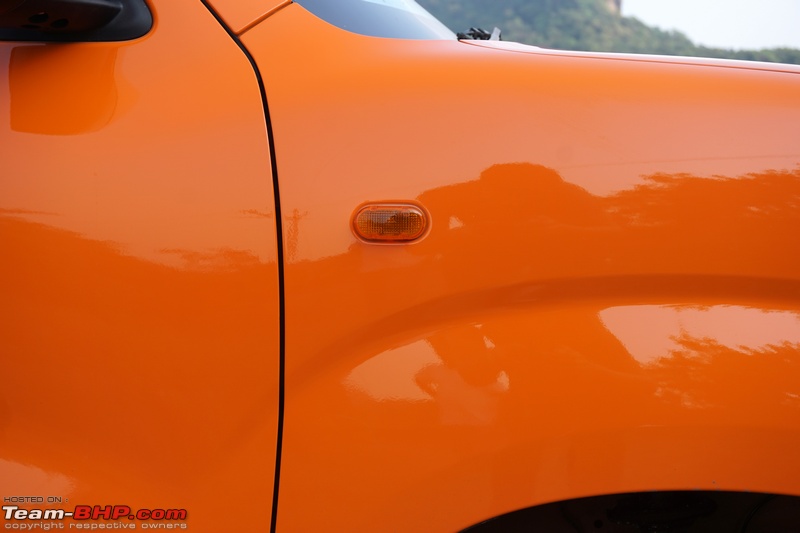 ...and bonnet... 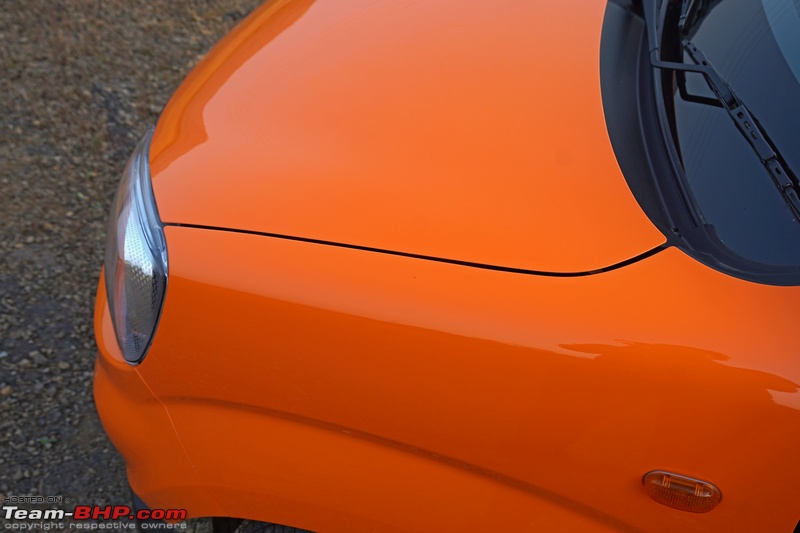 ...are tighter than those around the hatch: 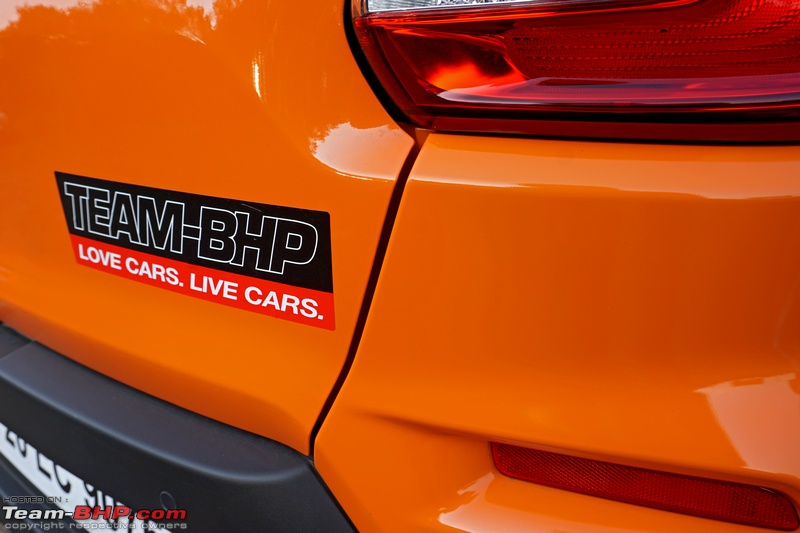 Gaps around the hatch are especially on the larger side: 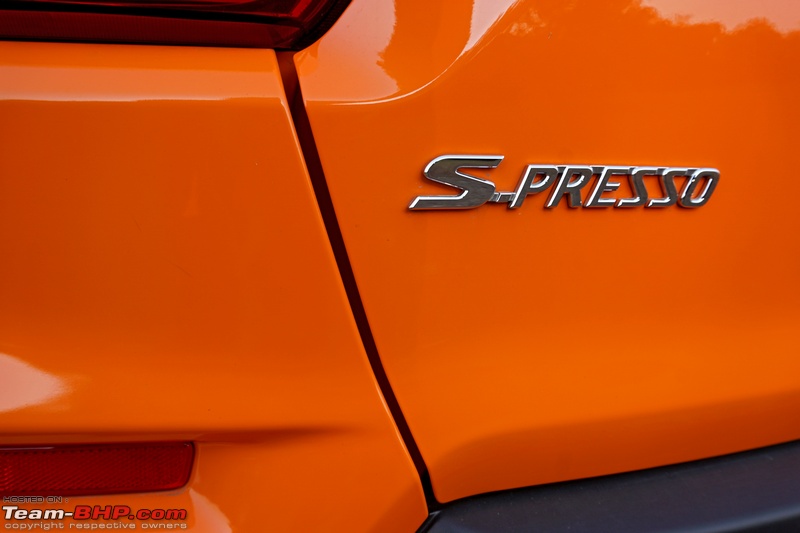 Body-coloured ORVMs can be adjusted manually from the inside: 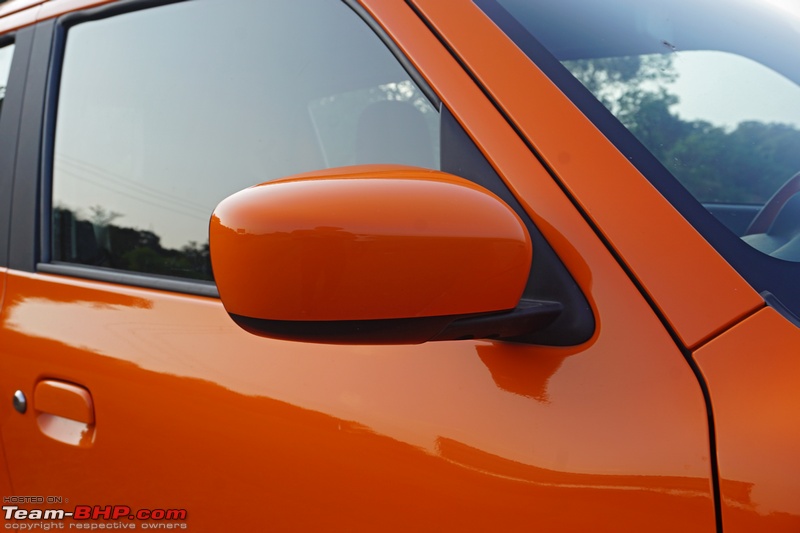 Small turn-indicators mounted on the fender look so dated! Reminded me of the Zen: 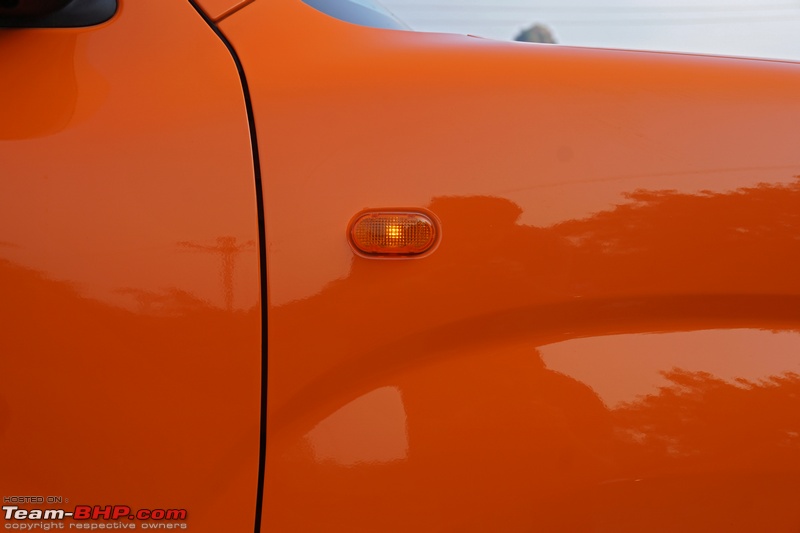 Body-coloured flap-type door handles feel so outdated. A 1990’s touch. Keyhole is present only on the driver's side: 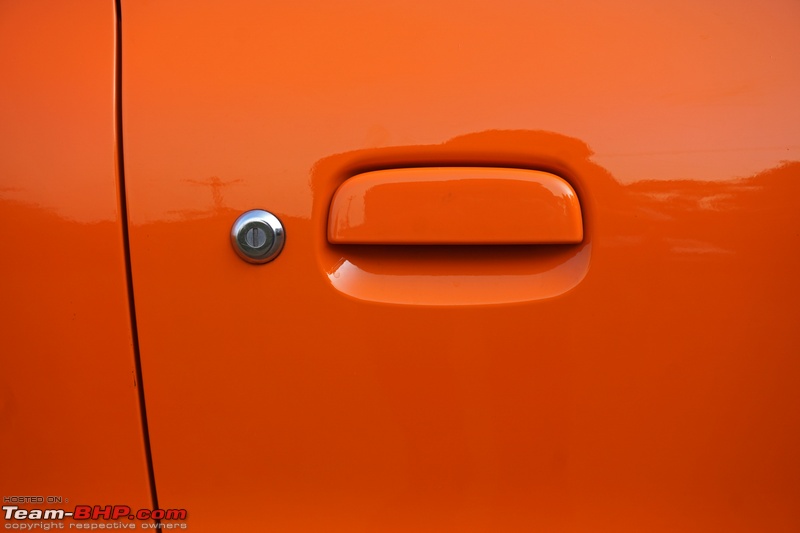 Glass area is decent and there is enough light entering the cabin. The B-pillars are blacked out. C-pillar on the thicker side: 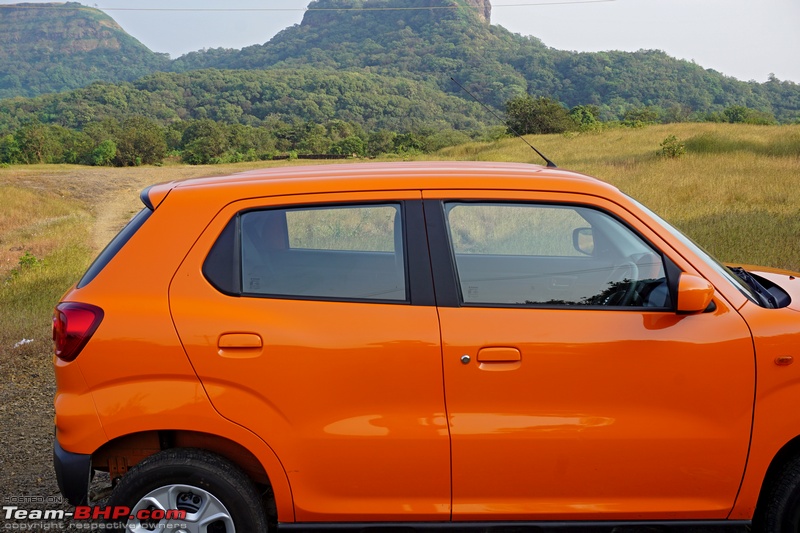 Wheels look way too small for the car. 14-inch steel rims with full wheel caps are shod in 165/70 section MRF ZVTV tyres. Base variants get tiny 145/80 section 13 inchers: 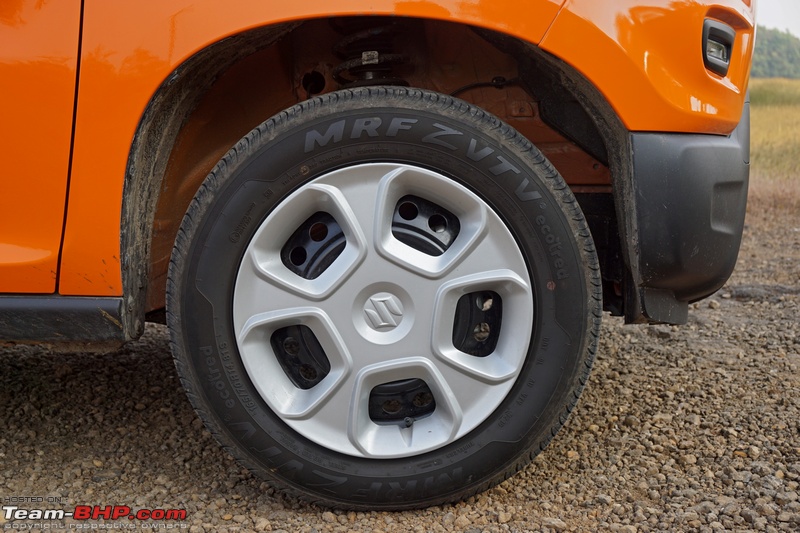 Wheel arches are prominent. The arch doesn't extend across the front doors: 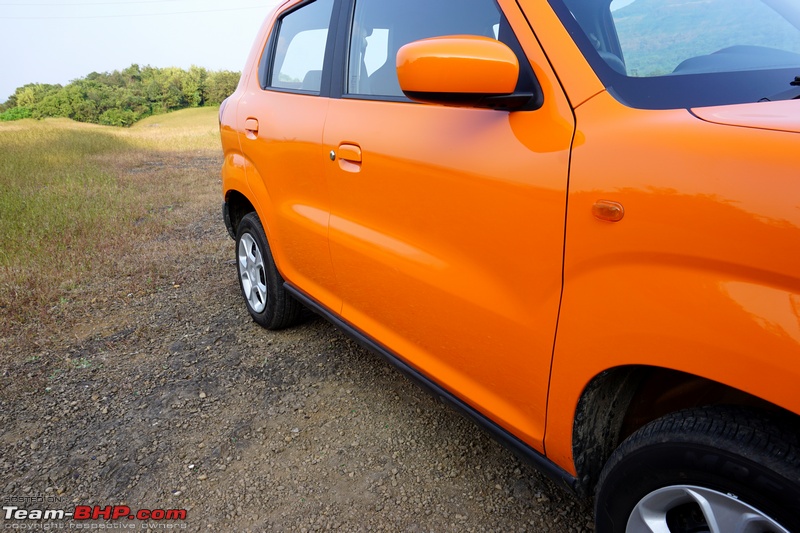 One more character line runs lower across the doors:  Ribbed roof to increase rigidity and minimize material weight: 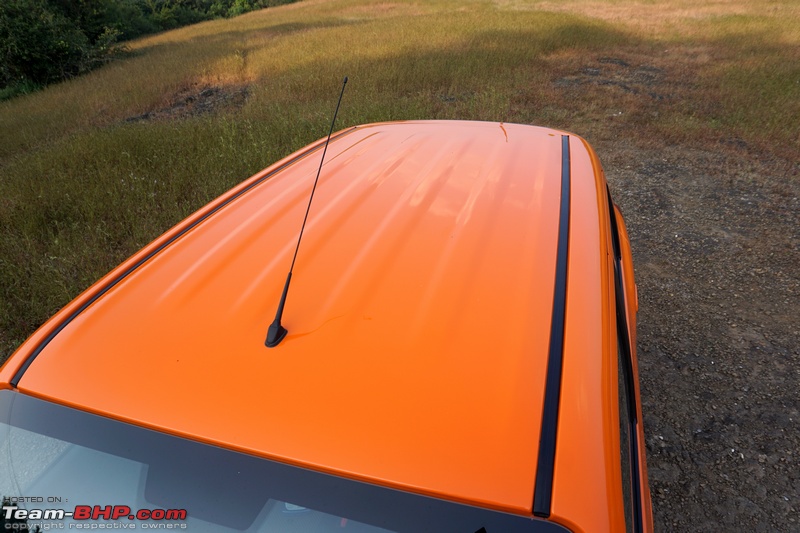 Long antenna is located at the front of the roof section. Its angle can be changed: 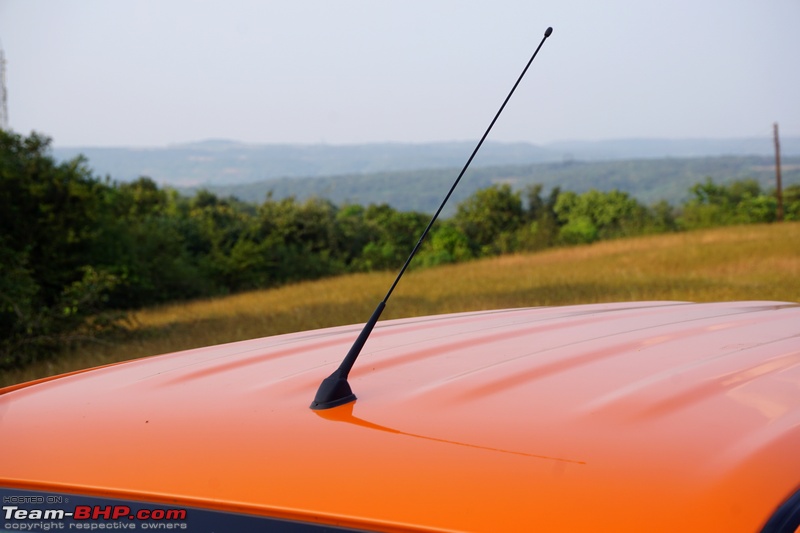 Black spoiler looks like an afterthought. The HMSL is located inside the car, rather than on the spoiler: 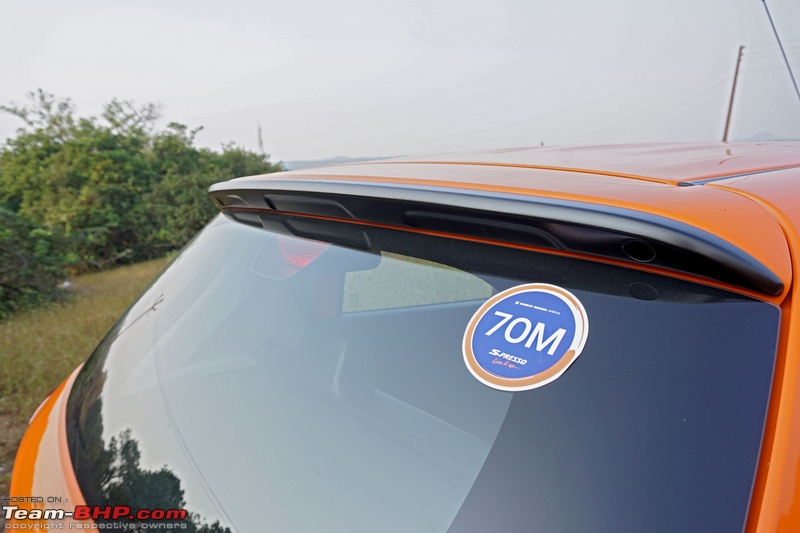 HMSL in action: 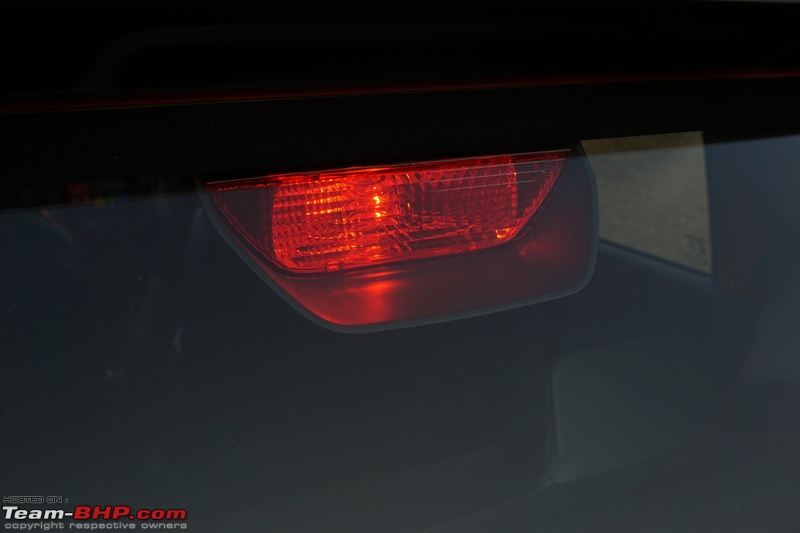 Tail-lamps intrude into the boot mouth and get a C-shaped design element for the brake light: 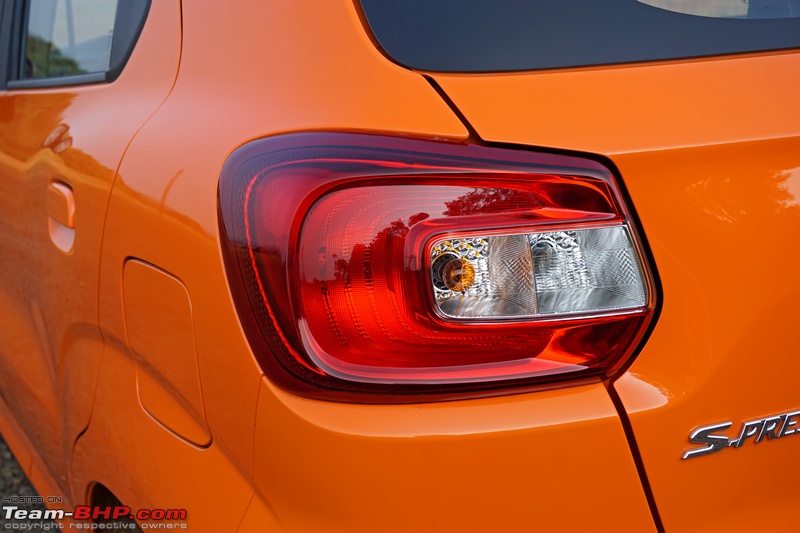 With all the lights in action: 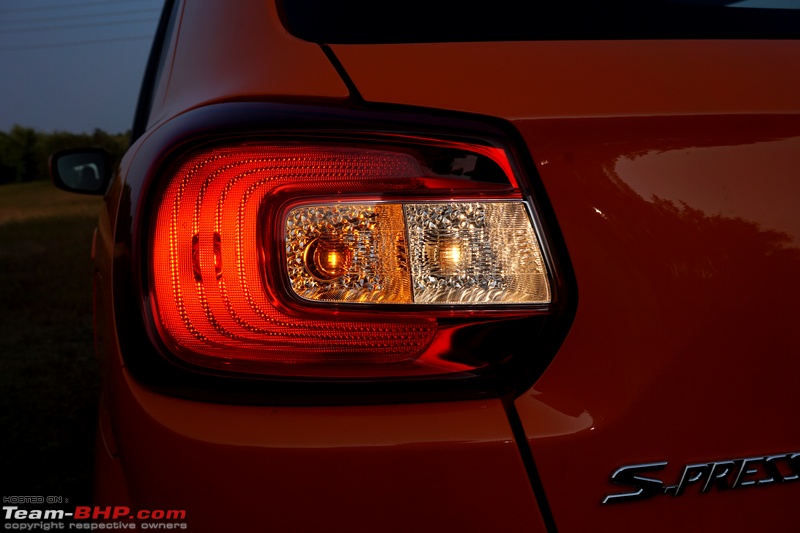 Hatch gets crease lines and shut lines that merge well with the rest of the body: 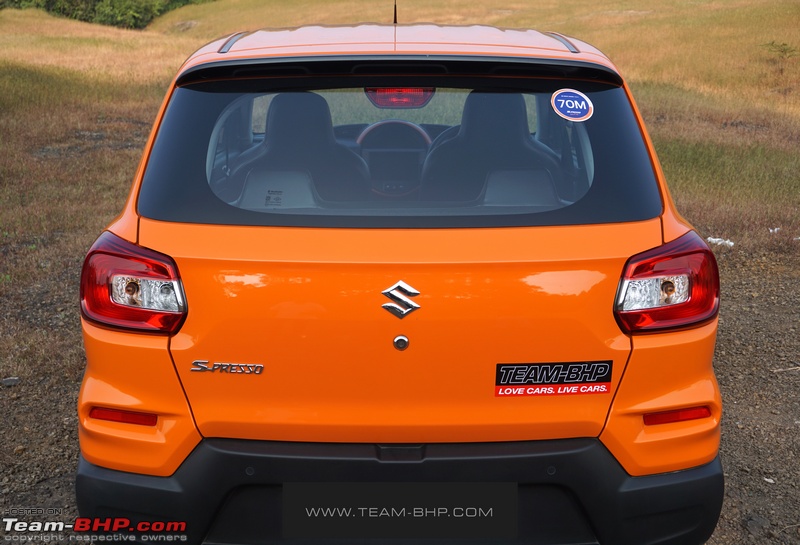 S-Presso badge on the left side. Notice how the letters are joined at the top rather than the bottom. No variant or engine / gearbox badge provided: 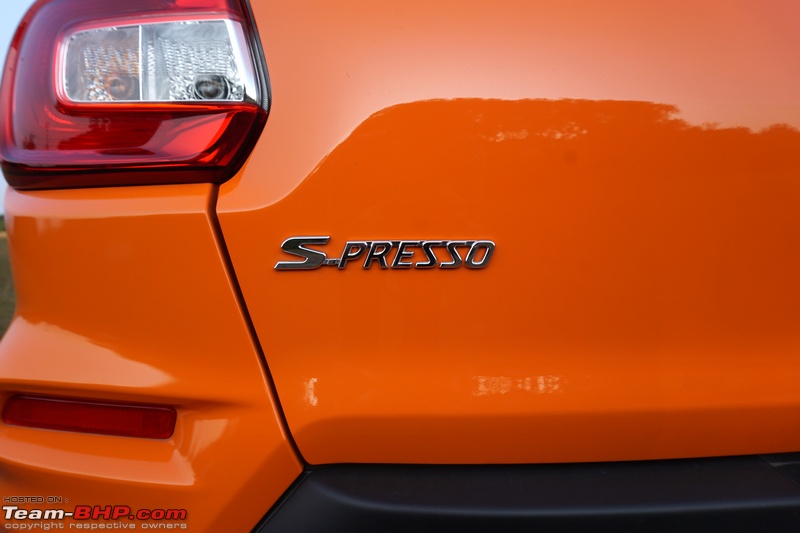 Two-tone bumper with black bottom at the rear as well. Horizontally oriented, slim, long reflectors are housed in indents in the body-coloured portion while the two parking sensors sit in the black portion above the number plate housing: 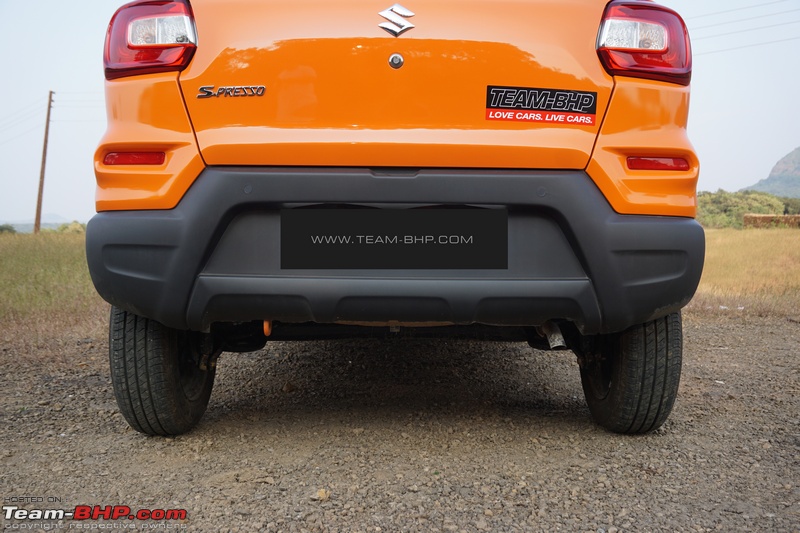 Rear suspension is a torsion beam with coil springs. Unladen ground clearance is rated at 180 mm. Notice the rear towing point located on the left. When idling, the tail pipe goes on continuously dancing and shaking: 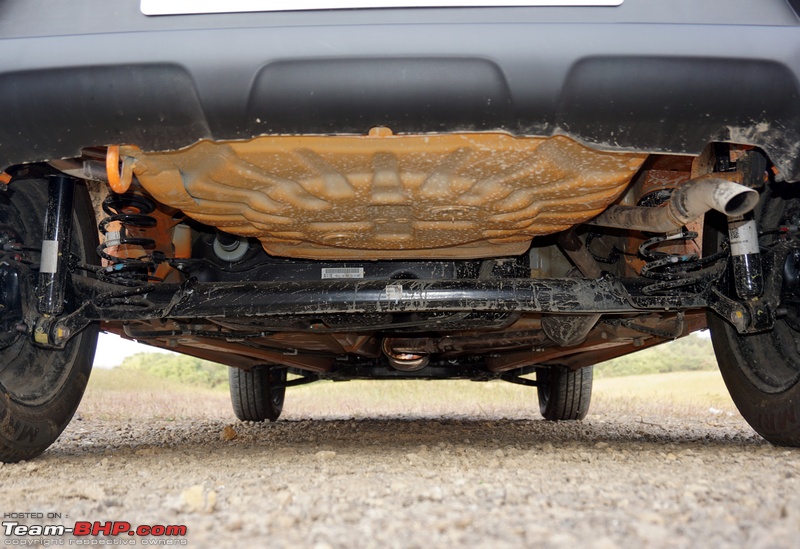 S-Presso looks tall and boxy compared to the more conventional Celerio: 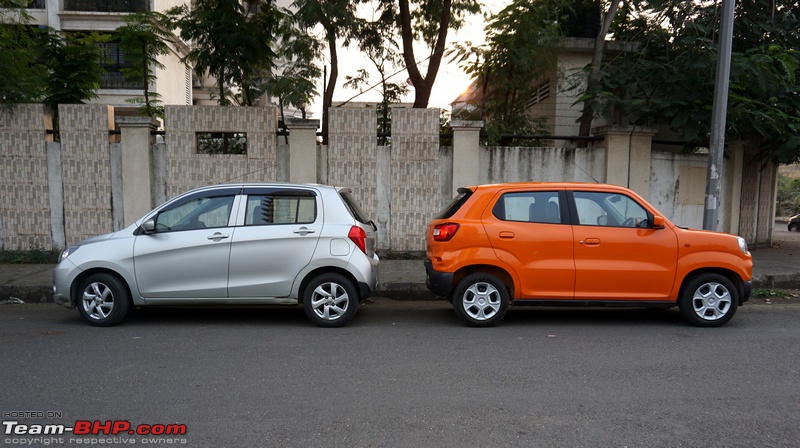 Last edited by benbsb29 : 8th May 2020 at 10:39. |
| |  (30)
Thanks (30)
Thanks
 |
| The following 30 BHPians Thank blackwasp for this useful post: | AdityaDeane, Balaji31582, bvasista, Chrome6Boy, dailydriver, deepfreak15, digitalnirvana, GTO, hmansari, InControl, manij, MDED, MSAneesh, N33raj, neil.jericho, Omkar, PM - B, Ponbaarathi, Punatic, RaghuVis, RavenAvi, Reinhard, Researcher, Romeo_Mike, Simhi, smuniswami, theexperthand, vaasu, vb-saan, vnabhi |
| | #4 |
| Senior - BHPian | Interior - Front 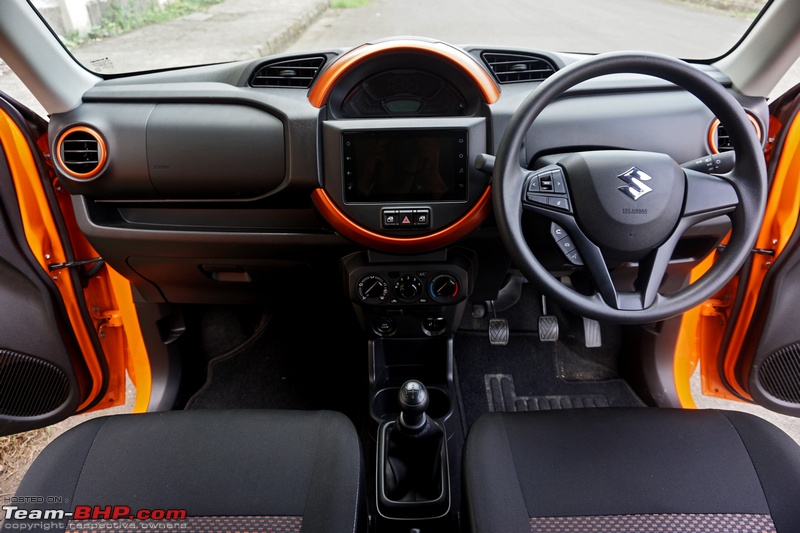 The front doors open and shut in a two-stage action. While the S-Presso is a small Maruti hatchback, its doors do not feel very flimsy. There is no European car like "thud" when you shut them, but they feel good enough for a budget hatchback. The doors open wide enough and the running board isn't too wide either. While the floor of the car is not very high, the roof is sufficiently tall to allow easy ingress & egress even for the elderly (although not as easy as the original WagonR). Once inside, the S-Presso has healthy legroom & headroom at the front. However, the cabin is narrow and the driver will definitely be elbowing the right arm of the front passenger while shifting gears. The cabin is so narrow that even without fully stretching, GTO could easily reach over to the other side and adjust the left side ORVM. The glass area is generous and there is enough light entering the cabin to keep occupants from feeling claustrophobic. The use of black on the dashboard, doorpads, seats, and grey on the pillars and roof gives a good balance of practicality and airiness in the cabin. The dashboard gets a centrally mounted instrument cluster and MID. It reminds us of the Mini Cooper. It has a black theme with orange / silver coloured inserts. The carpets and floor mats are black, which is well thought out for dusty Indian conditions. As expected for this segment, the plastics on the dashboard are all hard. The quality of the plastics is certainly at par with that of the S-Presso's main rivals in the segment though. The switchgear feels tactile and good to operate with no cost-cutting evident anywhere. There is no comparison to the Hyundai Eon or Santro, but frankly the interior quality is acceptable at this price. I donít foresee any owners complaining. The single area that feels cheap is the doorpad, which flexes very easily. Ergonomically, the cabin is well laid out and all controls are easy to find and reach. However, the cup-holders and storage console ahead of the gear lever are way too low. If you have your coffee cup out there or your phone, you are going to have to bend forward and go low down to pick it up. Itís as if Maruti raised the car, but forgot to raise the height of this storage area. Like the exterior, the dashboard also has a funky, unconventional layout. Reason? You guessed it = differentiation & to stand out. Black dashboard gets an orange coloured insert in the middle. The instrument cluster is centrally located with good-sized fonts. The entire cabin is practical, user-friendly and equipped with likeable features:  Nice and tall seating position, especially if you compare it to the likes of the Alto. Its not height adjustable but it will suit everyone. I love the frontal view, and even the protruding Mini-esque console on the center facia did not hamper my visibility. However, shorter drivers will have a problem. Not only will they find the straight up dashboard too high, but the bulging and the protruding center console is going to create a blind spot for the shorter drivers. Again, not for taller drivers. Further, you can see the bonnet while driving. Many people will like this:  Steering wheel is lifted from other Maruti cars, but gets an all-black theme. The only chrome bit is the S logo in the middle. Steering is slightly bigger than you'd expect in an entry-level car, but it's a user-friendly size and feels great to hold and operate. While the hornpad is easy to press, itís now a farther reach for those with shorter fingers. Totally sucks that the steering does not get tilt adjustment. It's fixed. Tall people will find the non-adjustable steering to be too far away. Its too close to the dashboard. Should have come out a little more. Another issue is that the steering is tilted way too much. I am feeling it at 5'10, shorter drivers will feel it even more. Its facing ďupwardsĒ a notch or two too much. The tilt angle should have been lesser. I am surprised with these two points as Marutiís ergonomics are usually spot on:  Buttons for controlling the audio system are on the left side. The volume and source can be changed via a toggle switch. Mute button will also pause the song that is being played:  Telephony controls have a unique location behind the wheel. Unlike earlier Maruti cars, you now have to press these buttons instead of pulling them towards you:  Orange coloured insert looks funky and helps reduce the monotony of the black dashboard. Cars with other exterior colours get a Silver finish here. Meters in the middle is a love it or hate it move. We had no problems with it after a couple of km in the car. The XL-size speedometer font makes it easy to read. Anyway, because itís a small car, you donít really have to turn your head to see it. Can view the reading in your peripheral vision:  Instrument cluster consists of a large digital speedometer in the middle, MID below it and warning lights on either side. Sucks that no temperature gauge or tachometer is provided:  Old & ugly stalk for toggling through the various functions of the MID:  MID is basic and displays the odometer, 2 trip meters, instantaneous fuel economy, average fuel consumption and distance to empty:  Wiper and light stalks are chunky and nice to touch. Turn-indicators have lane change feature in which the indicators flash thrice when the stalk is tapped lightly:  Side air-con vents are round. They get mesh grilles and orange coloured surrounds: 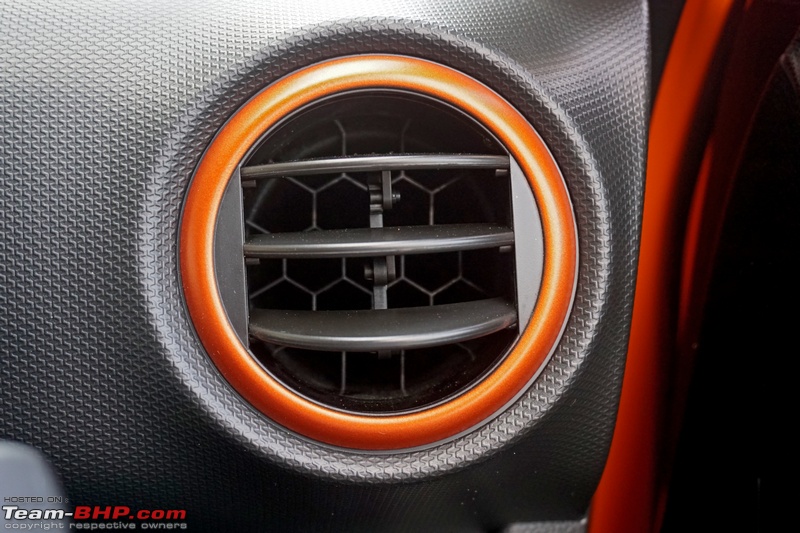 Side air-con vents can be shut, though they still let out a small amount of air: 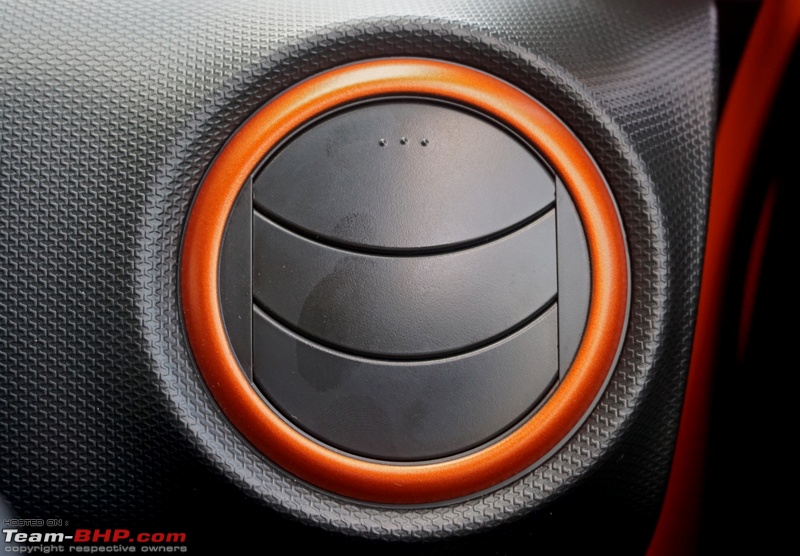 The 'DRL enable / disable' button sits to the right of the steering wheel. This is an aftermarket accessory. You have to long press to turn it on and long press to switch it off. If you press it even longer, then the DRL blinks:  Narrow cubby on the right of the steering can be used to store coins:  Outdated rotary knob and cable operated headlamp leveller feels outdated and cheap. It feels so from another generation. Although I must say that with this headlamp leveller, there is quite a difference between the minimum and the maximum adjustments:  Bonnet release looks cheap and requires a little more effort to open than expected:  Fuel and boot release levers are on the floor:  Like the dashboard, the doorpads get an all-black colour theme. There is a little movement of the doorpad when the windows are rolled down or up. Power window switches aren't located here (they are placed on the center console):  Stalks to adjust the ORVMs. Thanks to the narrow width of the cabin, it is possible to reach the passenger side stalk without even a full stretch:  Door handles are finished in black. Doors auto-lock at 20 km/h. None of the doors can be unlocked by just pulling the black door handles. To unlock them, one has to use the individual locks or the switch on the driver's door:  Bottle holder can accommodate a 500 ml bottle and other knick-knacks. A slimmer 1L bottle could also fit, but the one I had didn't get in:  Front seats are upholstered in fabric. They are contoured, but not wide enough - even for me, I had my shoulders outside the seat back. Those with a healthier build will find it even more bad. Under-thigh and lower back support offered is sufficient. Shorter drivers will find the thigh support to be okay too because of the tall seating. However, GTO says that at 5'10, 40% of his thigh was outside the seat. The seats could have been firmer though, helping in undertaking longer drives:  The headrests are fixed. They are soft and placed at a good height, making them comfortable + protective for even taller drivers:  Sturdy and durable lever to recline the seat. Height adjustment for the driver's seat is not offered in any variant:  Fore & aft travel range is enough to accommodate tall & short drivers alike. Notice the lever in front of the seat which is used for this adjustment:  A closer look at the seat fabric pattern:  Seatbelts are fixed and not adjustable for height. That said, they are placed at a height that will suit most of the occupants. Pretensioners and load-limiters are standard on the VXi and VXi+ model and optional on the others:  A-B-C pedals are lifted from other Maruti cars. There is no dead pedal, but you can rest your left foot on the left side, or in front of the pedal like I preferred in this car (thanks to the taller seating position):  ORVMs offer a sufficient view of the things behind. They are neither electrically adjustable nor foldable:  IRVM covers the entire rear windshield, but the C-pillars do restrict visibility:  S-Presso's rear windscreen is par for the course. Again, notice that the C-pillars limit rearward visibility while parking: 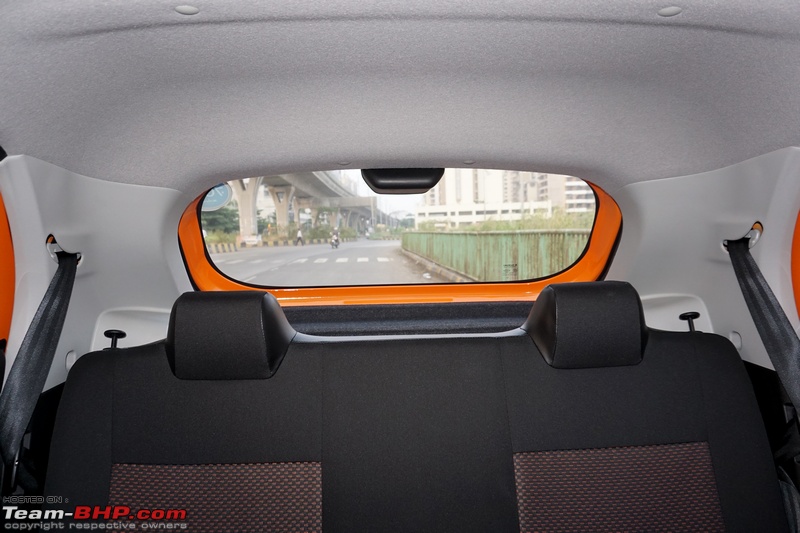 Center fascia is funky-looking, yet all the elements are logically designed. It gets orange semi-circular inserts at the top and bottom, a semi-circular instrument cluster on the top, infotainment system and buttons for the windows, hazard lights and AC controls down below. The power window switch position works! And because the hazard light button is between the two buttons, there is no mistaking which switch is for what window. No power window console on the door means additional lateral legroom at the front:  Trapezoidal center vents throw air on driver's hand and I had to adjust it so my hand didn't freeze:  7-inch touchscreen display of the Smartplay 2.0 infotainment system. It is covered separately in a later post. Below it are the power window controls and the hazard light:  Powerful air-con will chill you to the bone. It made me c-o-l-d even on a hot sunny day. Manual air-con controls offered. The slider for the recirculation feels very outdated. Like all Marutis, the AC was powerful and cooled the interior in no time. The fan is quiet at level 1 and audible at level 2. It gets loud at level 3 and very loud at 4:  Below the air-con controls are the 12V socket and USB and Aux-in ports. Both get plastic covers:  USB port to connect your smartphone to the infotainment head-unit in order to use Apple CarPlay or Android Auto. It is not a high ampere port and will charge modern phones slowly:  Small cubby at the base of the center fascia can hold a phone like the 4-inch iPhone SE. The larger screen phablets that are in vogue today will be tricky to place here. It wonít be able to hold some of them:  Two cup holders have been provided. This is the only place where you can keep a larger phone / phablet-sized device. But then it renders the cup holders unusable. Also, these are located far too down low so you have to make an effort by bending forward to reach them. It's as if Maruti raised the car, but forgot to raise the height of the storage area:  I love the placement of the gear lever. It's close to the driver - just at the right height and your hand literally falls on it. It's perfect. That said, maybe those with larger legs might face a problem:  Bird's eye view of the center console. Handbrake area is devoid of any storage for the front occupants. A single bottle holder is provided for the rear occupants: 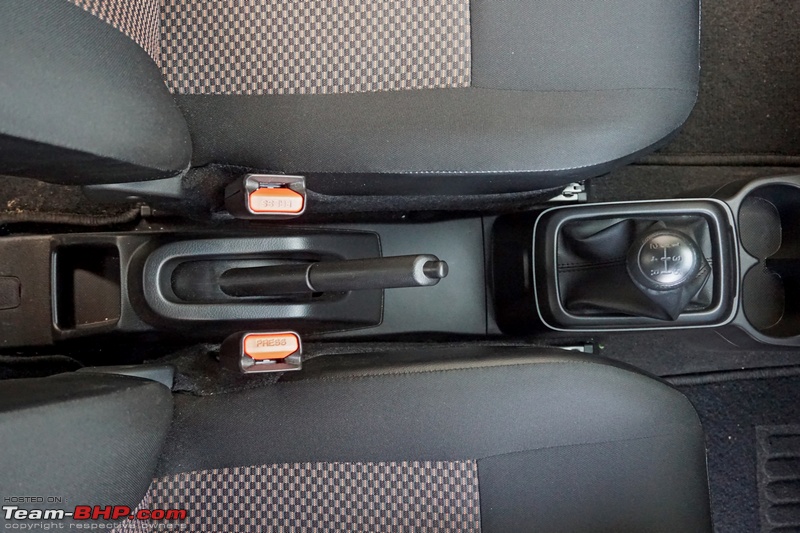 Passenger side of the dashboard gets an open storage space for small items. However, it has no lip, so items placed here will tend to roll and fall down under acceleration:  A 5.5-inch phone can fit here easily: 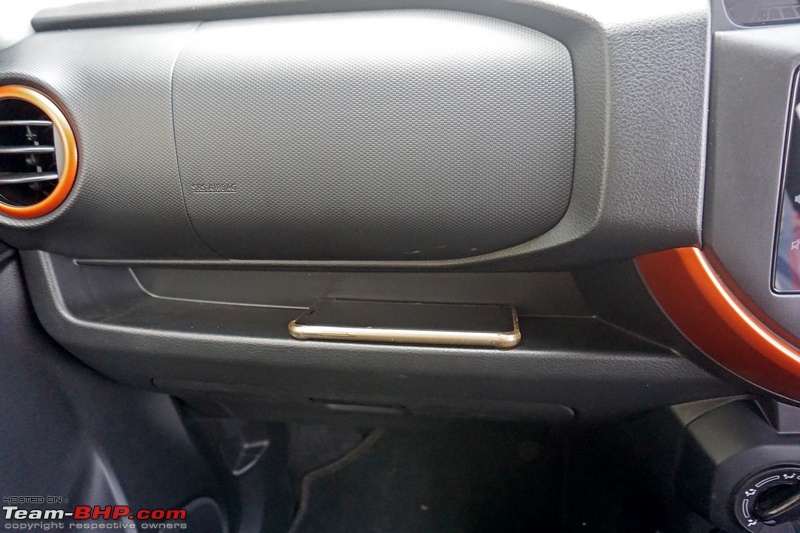 Glovebox has sufficient space to keep car documents and some more smaller items. It has no compartments, ventilation or illumination:  Just one cabin lamp at the front. But its not pointing downward. It's angled nicely to cover not only the front, but also the rear - it's almost like facing the rear seat. It is also powerful: 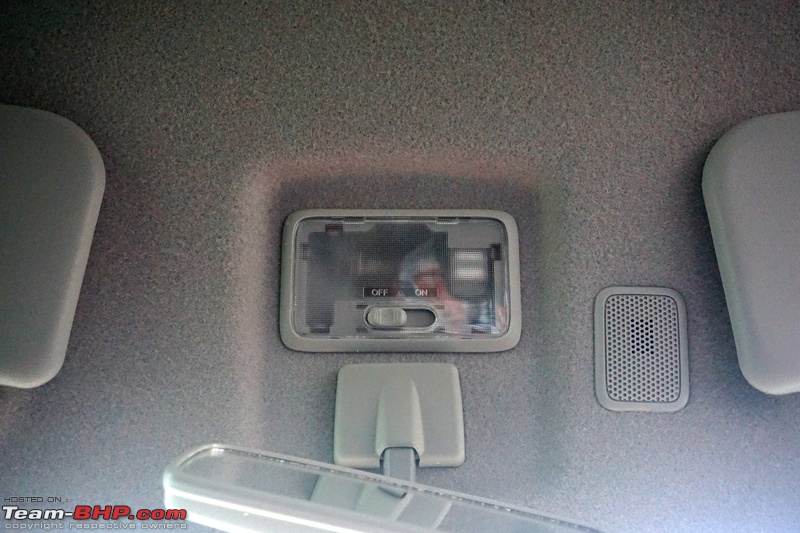 Bluetooth mic is placed towards the driver's side: 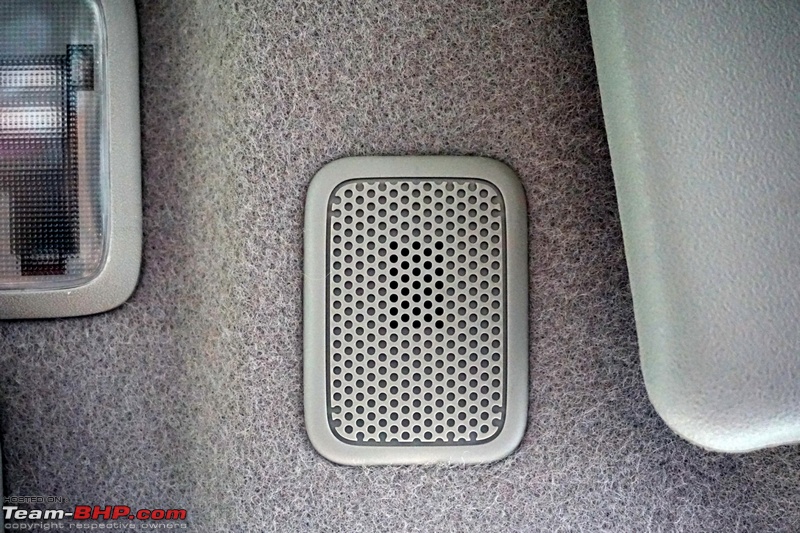 Sun visors are economy grade in design and feel. No ticket holder or vanity lamp on either one: 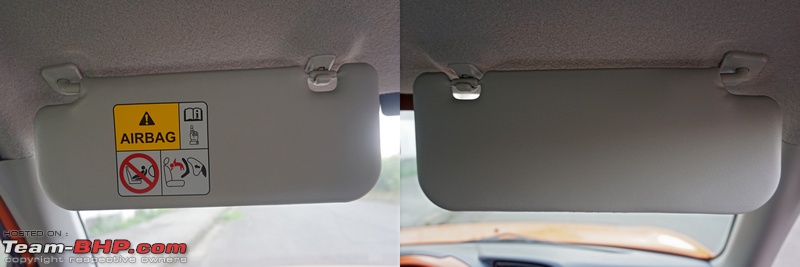 Passenger airbag is standard on the top variant and offered as optional on the lower variants (for just Rs. 6,000 more): 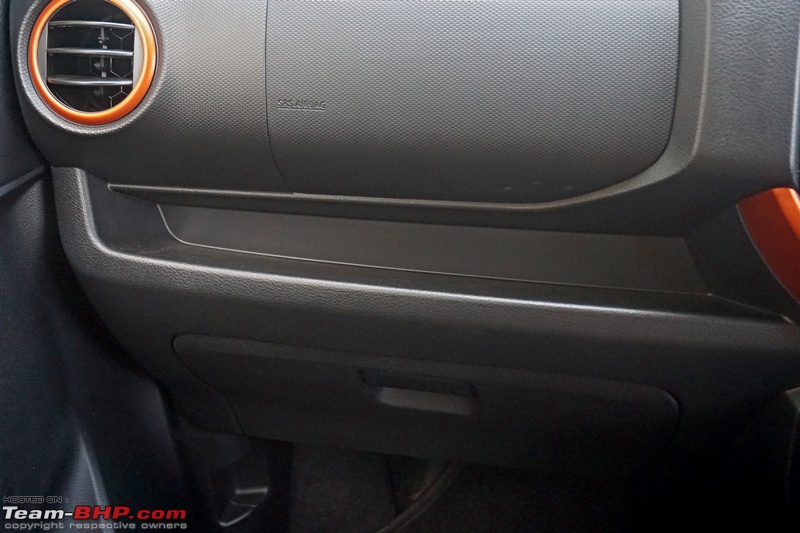 Things are neat and tidy even in places where most people wonít look. There are no loose wires or cables dangling anywhere. Here is a look under the dashboard in the driver's footwell... 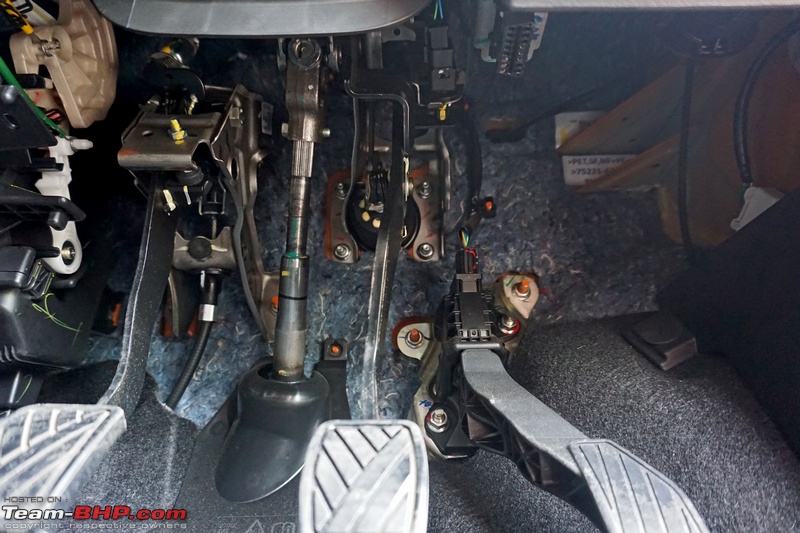 ...and in the passenger's: 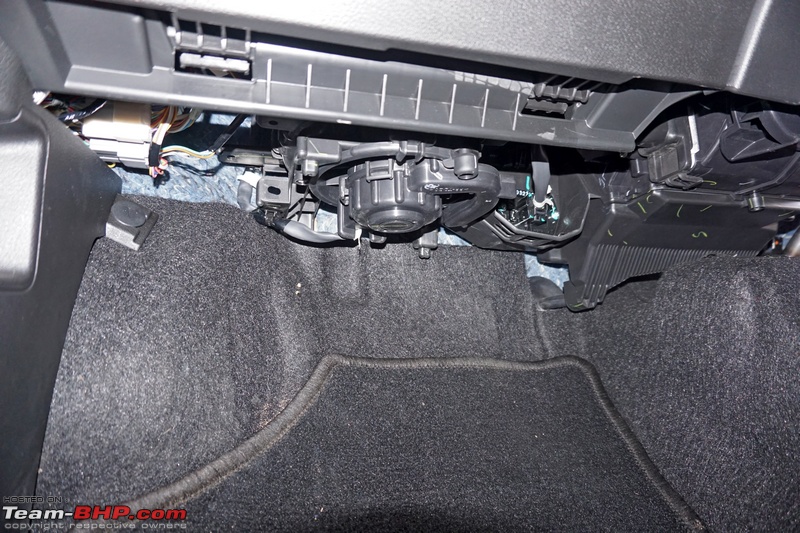 Last edited by Aditya : 20th February 2020 at 09:05. |
| |  (22)
Thanks (22)
Thanks
 |
| The following 22 BHPians Thank blackwasp for this useful post: | AdityaDeane, AYP, Balaji31582, Chrome6Boy, deepfreak15, GTO, hmansari, InControl, Leoshashi, manij, MDED, MSAneesh, N33raj, neil.jericho, PapaKiloSierra9, PM - B, RaghuVis, raptor_diwan, RavenAvi, Reinhard, Simhi, vb-saan |
| | #5 |
| Senior - BHPian | Interior - Rear The S-Presso's rear doors open in a two-stage action. They open sufficiently wide. The high roof of the car combined with the comfortable floor height makes ingress easy. At the same time, the seat is placed at a comfortable height, which means you donít have to sit down in it:  Adequate gap between the B-pillar and seat makes it easier to step in & out:  Door sill is not very wide either, which means occupants do not have to swing their feet much:  Like the front doorpads, these have a black theme. There are no rear speakers or power windows. Also missing are any storage pockets:  2 adults and a child at the most will be able to sit comfortably here. This isn't a place for 3 adults - there is simply no width for another person. The S-Presso is not a very wide car. The seat base and backrest are largely flat with no contours to speak of. There is no center armrest (Kwid Climber offers one):  Outer occupants get small & fixed headrests, which are pointless for everyone except shorter folks. Nothing for the middle passenger though:  Legroom is adequate; and surprisingly two six-footers can actually manage to sit one behind the other. Believe it or not, this small car can accommodate four 6-footers with ease!!!  The seatbacks are not scooped out, however they are soft. If the rear seat occupants' knees touch them, they will not feel uncomfortable:  Middle passenger gets a lap belt while the seat belt holders get dedicated cutouts in the rear seat:  A look at the minimum and maximum legroom:  With seats adjusted to Aditya's (he is 5'10") driving position, he has about 4 inches of leg space. With the seat pushed all the way back, his legs still do not touch:  Further, the front seatbacks are upholstered in carpet material at the bottom where the legs of the rear passengers might touch them and there is lots of space to stretch your feet under the front seat:  The rear seat is at a comfortable height and offers decent under-thigh support. The backrest is comfortably angled and the headroom offered is good. At 5'10", Aditya had over 3" of clearance. Overall space is healthy. Main complaint = the headrests are too small and low. They are absolutely useless:  The headrest barely reaches the top of Aditya's neck:  Window is large and allows a good deal of light to enter the cabin. A quarter glass would have improved this even more, but we are not complaining. Also note the seat belt position. I found it comfortable for my height but shorter passengers might feel it too high:  Storage at the rear sucks. Just one spot on the center console, behind the handbrake - no door pockets and no seatback pockets as well:  Fixed grab handles above each passenger door. No coat hooks provided:  Floor hump is about 4 inches high and about 4 inches wide. The middle passenger will prefer to put his feet on either side of the hump:  270L boot space with the parcel tray removed is larger than the Alto (210L) and Celerio (235L). The boot is well laid out - practical and useable:  Parcel tray can be used to place small things. It has a prominent border to prevent items from rolling onto the rear seat:  These knobs on either side of the seats can be used to fold down the backs:  A look at the rear seat with the seatback folded down (doesn't go completely flat though). While every variant gets a folding rear seat, none have a 60:40 split folding option:  Boot lid gets only a partial cladding to hide the mechanical bits:  Notice the protrusions due to the wheel arch. You need to account for these when planning to carry large pieces of luggage:  Loading lip is not too wide...  ... but it is high and you will have to ďlift upĒ your bags to load luggage. The boot opening is wide though, making things easier. The loading lip does not have any cladding and the weld marks are clearly visible:  Lift the boot floor up by sliding your finger in this hole:  Spare wheel is of the same size as others. It is secured using a long bolt:  All the tools and the first aid kit are packed in a plastic bag. The warning triangle gets a plastic pouch, but the rest of the tools don't:  Last edited by Aditya : 20th February 2020 at 09:06. |
| |  (22)
Thanks (22)
Thanks
 |
| The following 22 BHPians Thank blackwasp for this useful post: | AdityaDeane, AYP, Balaji31582, bvasista, Chrome6Boy, deepfreak15, digitalnirvana, GTO, hmansari, InControl, Leoshashi, MSAneesh, N33raj, neil.jericho, phynix123, Punatic, RaghuVis, RavenAvi, Reinhard, Romeo_Mike, vaasu, vb-saan |
| | #6 |
| Senior - BHPian | In-Car Entertainment The VXi+ variant gets a 7" capacitive touchscreen head-unit dubbed the 'SmartPlay Studio 2.0'. Connectivity is through Bluetooth, USB and AUX-in. Voice commands, Apple CarPlay, and Android Auto are supported as well. A CD player is missing, though when was the last time you used one? Maruti has provided a couple of apps – Navimaps (by MapmyIndia) and AHA radio. These use your smartphone’s internet for navigation, playing music, displaying weather updates etc. Navigation is through Navimaps, Android Auto and Apple CarPlay. No variant gets a reversing camera and it is not possible to retrofit one either. The Renault Kwid offers one in the top two variants. Screen resolution and clarity are impressive for a car in this segment (same system is used in the Baleno facelift and the WagonR). Dedicated keys are provided for those who prefer to use them. Touchscreen is placed in the middle of the center fascia, which means that the driver doesn't need to take his eyes off the road. Under harsh sunlight, visibility is average:  Music is played through just 2 speakers - one each on the front doors. However, even though the VXi+ comes with wiring for the speakers in the rear doors, there are no speaker grills in the doorpad. Click here to read about a BHPian's experience with installing rear speakers from a Maruti dealer. Only option for owners is the rear parcel tray which is far from ideal. We expected terrible sound quality but were pleasantly surprised, especially for a budget car. The sound quality is impressive for an entry level car. Adjust the equalizer (bass, mid and treble the way you like it) and you will be pleasantly surprised too. Note: Its not quality sound – no, but its far better than you would expect in a 4-5 lakh Maruti. I've driven cars that cost 8 lakh rupees that had poorer sound than this:  Split screen displays both the clock as well as the media being played. Media, phone and connectivity shortcuts are provided as well. The left tab shows the current music being played and the top middle shows a digital clock. It is easy to understand and simple to operate. However, the touchscreen ICE interface does have a little lag, but it is not excessive (lag is lesser than what we saw in the MG Hector): 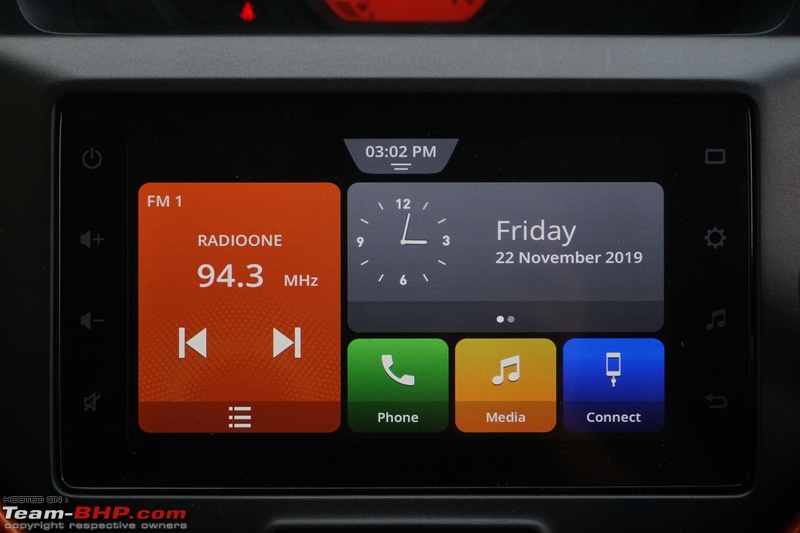 Top right display can be swiped to reveal the FE details:  Tap it and the fuel economy with current range as well as instantaneous mileage can be seen on this screen...  ...while the mileage history is seen here:  Pending vehicle alerts are also shown:  Some of the alerts include the door open warning...  ...the low fuel warning...  ...and the seatbelt unfastened warning (prominent warning for the front passenger too)  : : Media can be played through a variety of sources. This basic music system handles all tracks well, except the really bass heavy EDM / R&B stuff:  A variety of system settings can be configured as per the user's choice. Notice that the top bar displays the current song on the left and the phone battery, signal and Bluetooth status on the right:   Screen brightness as well as day/night or auto mode can be selected here:  Date and time settings include daylight saving, 24-hour format and display clock settings among others:  You can also configure the alerts that can be shown on the touchscreen. These include alerts for open door, parking brake, seatbelt, low fuel as well as a handy one for the low keyfob battery:  The open source license details:  Sound quality is better than the expected budget grade. Since only 2 speakers are given, the front occupants will hear music at a higher volume than the rear passengers. One good thing, however, is that the sound doesn't distort at higher volumes:  Set the equaliser manually...  ...or adjust the balance and fader:  A range of presets are also offered:  I like that you can independently adjust the phone, system and ringtone volume:  Speed dependent volume gets 3 levels or can be kept off:  It’s pretty cool that even in this class of car, you have Android Auto, Apple CarPlay and music controls on the steering. Not just that, you also have phone controls on the steering and you have a voice command button on the steering. Not bad for an entry level car. Connectivity options include via the Smartplay Studio app, Android Auto or Apple CarPlay:  When available, the bottom right tab changes to the available option (Android Auto in this case):  You get the updated Android Auto interface. However, it is slow at pairing with some phones (like GTO's Samsung S9). Took almost 45 seconds to find, recognize & set up. Further, it is slow to start Android Auto even after pairing:  The dark theme is good overall and especially at night. Here is the phone dialler. Almost all those who I called via Bluetooth / Android Auto or Apple CarPlay complained of poor quality of sound - the Bluetooth mic is poor:  Implementation of the Google Maps, as expected, is much better on Android Auto...  ...just like using the app on your mobile phone:  You can also play your songs using Android Auto:  That said, the interface got stuck this one time when GTO was driving: S-Presso gets Apple CarPlay as well. To use it, connect your smartphone to the system via a USB cable:  Songs can be played by the default Music app. If you are subscribed to Apple Music, it can be reached out from here as well:  Google Maps is now available on CarPlay:  This warning comes up when you pair a phone with the compatible mobile app:  These options are disabled until you run the SmartPlay Studio app on your phone:  A warning comes up:  And now you can access these options. Note than your data on the phone is used for this:  One of the preloaded apps is the AHA Internet radio. Music, news and sports channels are offered. It uses your smartphone’s internet for music etc.:  Music includes Gaana, personal radio, podcasts and internet radio stations:  Local FM stations that are also streamed over the internet are available here. Sound quality is much better than conventional FM:  Weather conditions (powered by Custom Weather) can be seen:  You can also get information about the nearby restaurants via Zomato:  Sport streams include games like cricket, football, etc.:  The SmartPlay Studio Remote app is available on both Android and iOS platforms. To prevent unauthorised access, one has to enter the VIN / registration number of the car. Only one instance of this app can be running (among all paired phones):  You can switch the audio system on/off with the app and choose the media source: 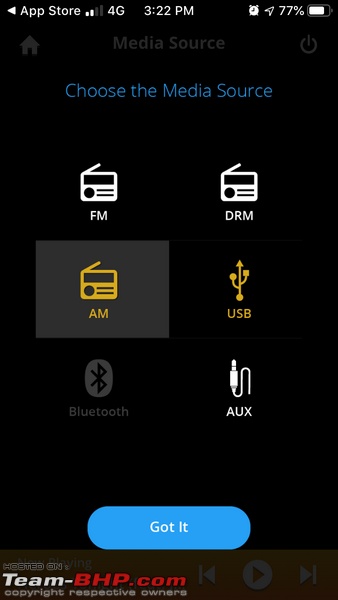 Songs / music playing can also be paused / skipped, etc. and the volume is adjustable as well:  You can also adjust the volume settings... 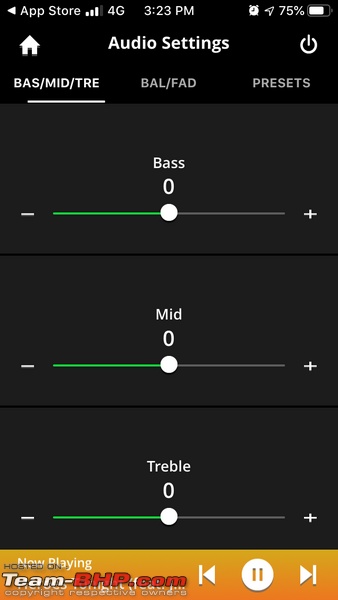 ... as well as the balance and fader... 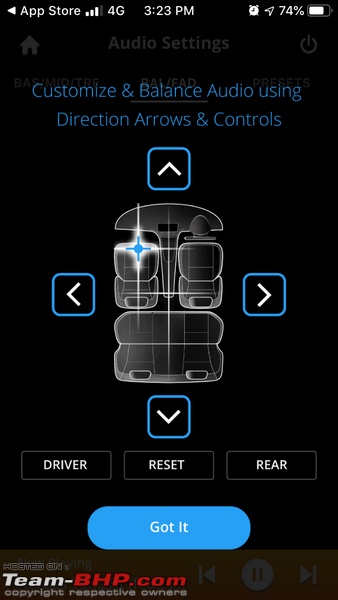 ...and presets as well: 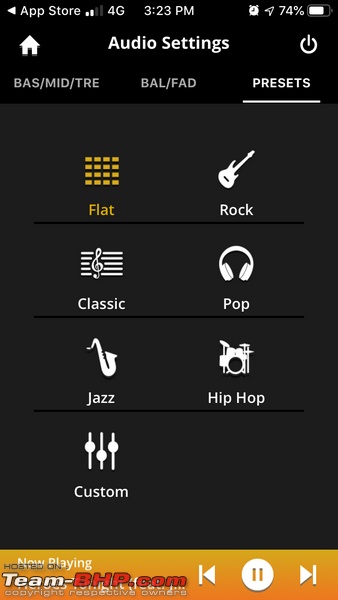 Vehicle alerts tab shows you the fuel / DTE information... 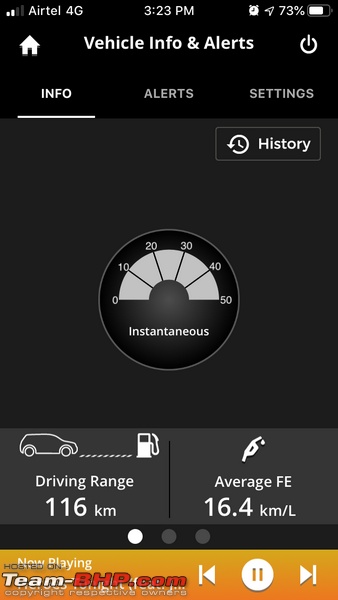 ...and the previous trip's fuel consumption: 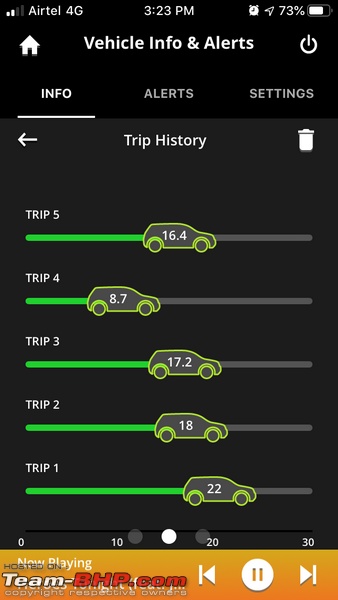 Any active vehicle alerts are shown here:  Menu includes personalisation options, settings, tutorial etc.: 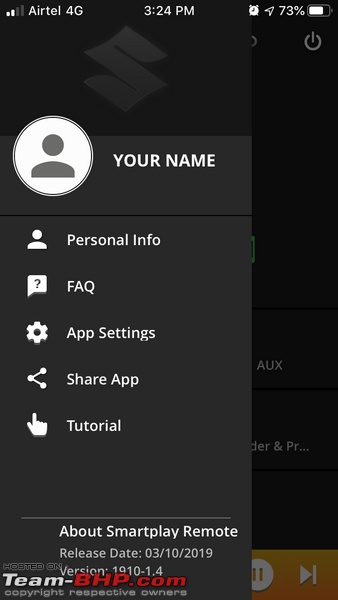 You can toggle phone notifications and vibrations incase of vehicle alerts: 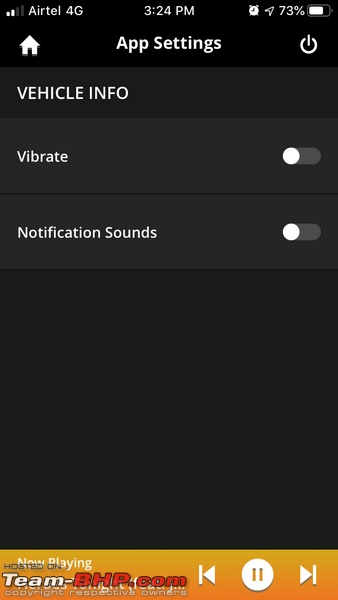 If you are using Navimaps for the first time, you will need to download the map data, which is provided by MapmyIndia: 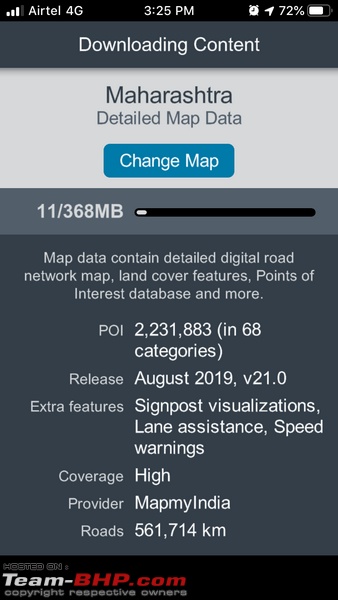 It is a paid service (subscription model). With Google maps these days, one doesn't need such dedicated navigation apps: 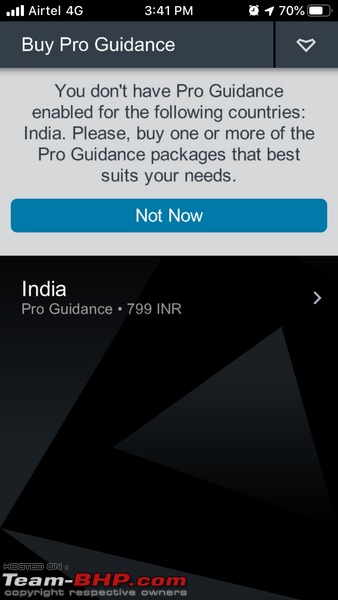 The free version shows you the directions: 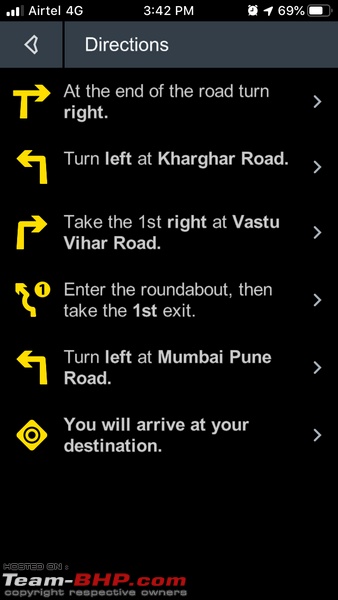 AHA Radio is also bundled - this screen shows that your phone is paired with the system and you can now access the AHA Radio on the head-unit:  Last edited by Aditya : 20th February 2020 at 09:08. |
| |  (17)
Thanks (17)
Thanks
 |
| The following 17 BHPians Thank blackwasp for this useful post: | AdityaDeane, digitalnirvana, GTO, harbinder_s, InControl, Leoshashi, manij, MDED, MSAneesh, N33raj, neil.jericho, raptor_diwan, RavenAvi, Reinhard, Researcher, Scorpion 10, vb-saan |
| | #7 |
| Senior - BHPian | Driving the 1.0L Petrol MT The S-Presso is powered by the familiar 3-cylinder, 998cc K-Series engine seen in many Marutis. It is now BS6 compliant:  In the S-Presso, the 1.0 engine complies with BS6 emission norms and produces 67 BHP @ 5,500 rpm and 90 Nm @ 3,500 rpm. With a kerb weight of merely 726 kilos, the car has a healthy power-to-weight ratio of 92 BHP / ton and a torque to weight ratio of 124 Nm / ton. Both these figures overshadow the car's A-segment rivals, and even some B1-segment models like the Santro, WagonR (1.0), Tiago and Celerio. The engine is sweet, has peppy performance and the gearing is absolutely spot on. This makes the S-Presso rather lively to drive. It has a punchy mid-range and good top end performance too. This is a nice, fuel-efficient & reasonably fast motor. Of course, the light kerb weight also helps the S-Presso's performance. Crank the starter and you immediately realise this is an entry level car. Typical of 3 cylinder units, there is a little cabin shake on cranking the engine, while mild vibrations are felt on idle. The S-Presso rolls off from a standstill without any fuss. It can easily move away from 0 km/h in second gear too! Driveability is excellent & the light weight makes things easy for this little 1.0. The motor feels very tractable in the city & itís got a practical state of tune. The healthy low-end & perfect gearing means you do not have to downshift too often. With its narrow width, small footprint, higher seating position, perfect ergonomics & lively engine, the S-Presso is an ideal city car. Out on the open road, the S-Presso's power to weight ratio is enough to keep up with hatchbacks from a segment above (not its handling though). The engine is revv-happy and a jewel amongst the 1.0L triple cylinders. On the expressway, you'll enjoy redlining this car all the way to 83 kph in second gear or 122 kph in 3rd gear. Overtaking is easy & fuss-free. The engine sounds good at higher revs too; not everyone is going to enjoy its audio track, but enthusiasts definitely will. Sadly, the suspension can't keep up with the engine and thus, we don't recommend going over 90 - 100 km/h on the highway. What you'll find extremely annoying is that whenever you drive in a pedal-to-the-metal style (i.e. flooring the accelerator), the ECU switches the air-con compressor off for that extra pep. Even if youíre climbing a flyover in a taller gear and floor the accelerator, the air-con cooling switches off. This compressor switching off action is far too aggressive and thus, affects the air-con's cooling. The S-Presso has a very healthy power to weight ratio & Maruti didn't need to do this. I had to find a workaround = while redlining on a fast highway, I found myself backing off the accelerator for a moment, waiting for the a/c cooling to start (within 4 to 5 seconds), and then pushing the accelerator all the way in again. The clutch is nice and light to operate, with just the right travel length. The 5-speed gearbox is good to use with throws on the shorter side. Itís a pleasure to operate, even if it is slightly rubbery. The NVH package is cheap & basic. The S-Presso does alright at city speeds. But as the revs climb, youíll hear that familiar 3-cylinder thrum that all of us know from the Maruti 800 / Alto. It is also louder than other Marutis with the same engine. Reason = poorer insulation. At 100 km/h, road & wind noise are high. Whatís worse, while driving over broken roads, youíll hear pebbles hitting the inside of the wheel arch (as there is partial / no cladding). The ARAI-certified fuel economy of the S-Presso MT is 21.7 km/l. This engine is known for its frugality & will leave owners no cause for complaint in the FE area. Free-revving petrol engine produces 67 BHP and 90 Nm:  No insulation under the bonnet...  ...or on the firewall:  Quite a small battery:  No underbody protection - not even a plastic sheet. You can see the ground below clearly:  Factory fit cold air intake   Last edited by Aditya : 20th February 2020 at 09:09. |
| |  (24)
Thanks (24)
Thanks
 |
| The following 24 BHPians Thank blackwasp for this useful post: | abhinavinc, AdityaDeane, AYP, Balaji31582, Big Smoke, bvasista, digitalnirvana, GTO, InControl, Leoshashi, manij, MDED, MSAneesh, N33raj, neil.jericho, PM - B, RaghuVis, RavenAvi, Reinhard, Researcher, Scorpion 10, vaasu, vb-saan, VijayAnand1 |
| | #8 |
| Senior - BHPian | Driving the 1.0L Petrol AMT Apart from the 5-speed manual, the 1.0L petrol engine is available with a 5-speed automated manual transmission. Like in its other cars, Maruti calls it "Auto Gear Shift". The 5-speed AMT unit is sourced from Magneti Marelli and is being offered in the VXi and VXi+ variants. The AMT mechanism is a simple bolt-on job and it uses the S-Presso MT's existing gearbox. Itís pretty straightforward in the way it works. Mechanically, the AMT gearbox is identical to the S-Pressoís manual transmission. What's different is how the clutch is operated and how the gears are shifted. In the manual, the driver is responsible for these tasks. With the AMT, hydraulic actuators located in the engine bay operate the clutch and shift gears. There's no clutch pedal, and zero driver input is required for gearshifts, making it exactly like a conventional automatic to drive. Simply put, the mechanical functions of operating the clutch and gear lever have moved from inside the cabin to the engine bay. To know more about AMTs & how they work, click here. Starting the engine up must be done with the gear lever in Neutral. You have to press the brake pedal as well, else the engine won't fire up. There's no 'P' (park) mode or gear unlock button like in a conventional AT. Once fired up, slide the gear lever to 'D' (drive) to get going. As you release the brake, the car will move forward without any accelerator input. However, it doesn't move too fast and will top out at about 6-7 km/h, without any driver input. When you press the accelerator, you'll notice that throttle response is quite immediate. It's exactly like a pure manual in this respect. In city traffic is where the AMT truly shines and brings the most benefits. There's no clutch pedal and there's no requirement for the driver to repeatedly shift between Neutral-1st-2nd either. In crawling bumper to bumper traffic, you don't need to give any accelerator input. Just release the brake a little bit, and the car crawls forward. Start-off is extremely smooth. At these speeds, there is no difference felt between the AMT and a conventional AT. In fact, this is more like a DSG in stop & go traffic since the mechanism is identical (but only between Neutral and 1st gear). Budget car owners will love the fact that their left leg is completely relaxed. The tricky part with the AMT in city driving though is parking into tight spots. Unlike a conventional AT where it's possible to ease the car forward very gradually, the AMT is more of an 'on or off' solution, as it tries its best not to slip the clutch more than required. This results in a more eager movement, which can be a bit tricky when getting in & out of tight parking spaces. Gear-shifting quality is a universal sore point for Automated Manual Transmissions. The S-Presso's AMT is no different & there is absolutely no comparison to the Santro's far smoother AMT. Despite the start-off from standstill being seamless, it's the following gearshifts that are indeed noticeable. First-time automatic drivers won't have any complaints with the AMT. However, those used to smoother AT gearboxes will definitely notice the compromise. The first time you drive off, you'll be accelerating and then, there is suddenly a lull in acceleration when the car shifts up to 2nd gear. You can certainly feel this drop in momentum, as the clutch disengages and engages, especially from the driver's seat. On your first few drives of the AMT, this upshifting and the resultant loss in acceleration can get annoying!! Another example: If you're cruising along at 40 km/h in 4th gear, and you press the accelerator to get a little more power, you'll feel a lull before the acceleration actually kicks in - because the gearbox is shifting down to 3rd gear. On each gearshift, you feel your body move forward due to the mismatch of anticipation and reality. The lag in power during gearshifts is more noticeable during uphill climbs, since the drop in acceleration is more pronounced. Sounds like a disappointment? Fret not. There's a silver lining on this cloud. Firstly, no matter how evident the gearshifts seem to the driver, passengers won't notice them. Passengers just don't anticipate shifts the same way the driver does, and this makes it a smooth ride for them. Secondly, there are some simple driving tips you can apply to make your gearshift experience smoother. If you drive with an extremely light foot, the shifts will be much less perceptible, since the drop in acceleration at each shift won't be as large. Another tip that some might get used to, others will find cumbersome: When accelerating up to speed, let off the accelerator at intervals, and the AMT will seize that opportunity to upshift. E.g. When going from 0-40 km/h, let off the accelerator very slightly at 10, 20 and 30 km/h, and the AMT will take each one of those opportunities to upshift a gear - almost like you told it to! Finally, you'll be happy to know that shift quality gets better between higher gears and is virtually seamless when going downhill. It's also completely silent in its operation. There's absolutely no noise or clunking when the gears shift. Fuel efficiency is without a doubt what the AMT has been tuned for. This means the transmission is very eager to upshift and before you know it, you will be cruising along in 5th gear at speeds of 50 km/h. Even in crawling traffic, the AMT will upshift to 2nd gear at fairly low speeds. When the rpm levels drop, the transmission will downshift to a lower gear. The 'current gear indicator' on the MID keeps you in the loop as to which gear is engaged. It's quite a novelty and will be appreciated by prospective and existing owners of the S-Presso AMT. It adds to that premiumness, as even some of the more expensive cars don't have this feature. The engine gives out a nice blip on kick-down, and doesn't hesitate to drop two or three ratios at a time (e.g. 5th to 2nd). With a heavy foot on the accelerator, the AMT holds a gear all the way till the end of the rpm range before upshifting. The driver also has an option of 'manual mode' to prevent premature upshifts while overtaking on highways. Manual Mode has other advantages, especially for the more enthusiastic drivers who want a higher degree of control. Like other hatchbacks with AMTs, the S-Presso offers a tiptronic-like manual mode. Towards the right of the MID gear indicator, there is a small alphabet readout: 'M' for Manual & 'D' for Drive, indicating the mode that you are currently in. In manual mode, the AMT will still not upshift automatically unless you reach the end of the rpm range. Conversely, if the rpm drops too low, the AMT will downshift to prevent the motor from stalling. If you try to upshift at too low an rpm or downshift at too high an rpm, the AMT will ignore your instructions and flash the gear indicator in protest. It's always a good idea to switch to manual mode before your favourite ghat section, because it prevents sudden & unsettling gear changes mid-corner. 0-100 times are also best tried in manual mode, but they certainly won't match up to the true manual S-Presso. Why? For a hard launch, the AMT takes almost an entire second to realise the urgency and even after that, it won't charge ahead, but instead move leisurely. The S-Presso MT is quicker as you can build the revvs and dump the clutch at launch. Even upshifts aren't as quick as what a good driver can pull off (leave aside the lightning-quick DSG's shifts). An advantage of manual mode is that you can increase the amount of engine braking when going downhill. It's quite effective, although not as aggressive as in a pure MT. We recommend shifting to manual mode before overtaking, when you need engine braking and of course, the times that you are in the mood for some fun. Hill starts require that you use the correct procedure in order to minimize rollback. When starting off on a hill, switching your foot immediately from the brake to the accelerator will result in the car rolling back...before it engages the clutch and moves forward. On a steep hill, the car can roll back as much as 3 feet before moving forward. It's dangerous, and also bad for the clutch in terms of wear & tear and overheating. In fact, there's a special 'transaxle overheating' warning light just for this. Thus, it's best to use the parking brake when starting off on an incline. This results in only an inch or two of rollback and a very gradual start-off. A 'Hill Hold' braking function would have been a neat addition, but we can't complain too much considering its affordable price tag. I'd also like to add that the AMT manages the clutch & gearbox a lot better than sub-par drivers out there. There's no doubt that it is more talented than a below-average driver in choosing when to shift, how to shift and what gear to drive in. Like the MT, the S-Presso 1.0L AMT has an ARAI-certified FE of 21.7 km/l. The Magneti Marelli sourced hardware sits on top of the 5-speed gearbox:  Shifter for the AMT is lifted from other cars in the stable:  Shift to the left for 'manual mode'. Move it down for upshifts & vice versa:  R, N, D & M are backlit in orange:  No clutch pedal means more space in the footwell. The dead pedal is missing. A comfortable dead pedal is most important in an AT to rest the idle left foot:  Foot on the brake symbol lights up to remind you to press the B-pedal when changing from D to R or cranking the engine in N:  AMT's MID gets a gear indicator. The "D" next to the "1" denotes "automatic" mode, while the "M" with the "1" is the "manual" mode. Currently selected gear is shown in both, automatic & manual modes. The transmission allows you to shift up to 2nd gear even when the car is standing still:  Last edited by Aditya : 20th February 2020 at 09:10. |
| |  (20)
Thanks (20)
Thanks
 |
| The following 20 BHPians Thank blackwasp for this useful post: | AdityaDeane, ashis89, Balaji31582, Chrome6Boy, digitalnirvana, GTO, InControl, Leoshashi, MSAneesh, N33raj, neil.jericho, PM - B, raptor_diwan, RavenAvi, Reinhard, Researcher, Roy.S, Scorpion 10, vb-saan, Vmv |
| | #9 |
| Senior - BHPian | Ride & Handing The S-Presso comes with a McPherson strut suspension setup at the front and a torsion beam setup at the rear. The overall ride quality is firm. While it's liveable & not a deal-breaker, it's still on the firmer side. The downside to jacking up a car's height is that you have to firm up the suspension. Otherwise, your handling will be all over the place. Still, this is one of those rare cars that neither rides nor handles well. The ride quality is such that you feel everything on the road. And cars from this segment anyways have basic suspensions, so the absorption quality is not something that owners would be raving about. While small bumps on the road are tolerable, large / sharp ones make themselves felt and are jarring for the occupants. The car gets jiggly over uneven roads and can get choppy at speed. There is vertical up & down movement too. Pro tip: Small bumps & undulations are better taken at speed. Continue driving at your speed instead of slowing down for smaller rough patches. That said, if you go too fast over larger bumps, the ride gets very bouncy and uncomfortable. We would definitely recommend slowing down for large bumps and potholes. I distinctly remember the Kwidís ride quality to be superior; thatís an advantage the Renault has. The suspension is not silent in operation either. You can hear it going about its work, especially on bad roads. It must be noted that lower variants with 13" rims & taller tyre sidewalls might ride a little better. The high-speed stability of the S-Presso is okay. Just donít push it too hard. The car is at home most in the city, not on the highway. I thoroughly enjoyed driving this peppy little thing in the city, but not so much on the expressway due to its road manners. On broken roads, the car suffers side-to-side body movement that can make passengers uncomfortable. The rear end can get bouncy on road undulations too. Crosswinds affect it on the expressway; if you take it on the highway, drive it in a sedate manner. You can feel the lightweight nature of the car at speed. Whatís worrying is that while the engine will easily take the car to high speeds, it isnít capable of handling that. In such a small & light car, we wouldnít recommend going over 90 Ė 100 km/h on the highway. Donít get me wrong - straight line stability is okay. Even at 110 - 120 km/h on the expressway, it didnít feel overtly nervous in a straight line. But it canít handle an emergency manouveur or fast lane change at those speeds. The car itself - we can guess going by Maruti's track record - has a basic level of crash test safety. Frankly, this kind of car is best restricted to city use only. In a nutshell, the car is awesome in its natural habitat - the city. Itís narrow width + tall seating + good low end + peppy engine make it easy to dart in and out of traffic. But on the highway, it is mediocre. In terms of handling, you must remember that it is a tall car. Body roll is present and this is not a car you'd like to corner hard in. The S-Presso doesnít like fast lane changes either. You have to be really calm and have a sedate driving style on the open road. Grip from the 165/70 R14 MRF ZVTV tyres is acceptable at city speeds, but they are too narrow and designed more towards mileage than grip. Please get fatter tyres for better handling & for safety reasons. Theyíll make the car look better too. The S-Presso comes with electric power steering. It is weird, poorly calibrated and feels more like a Mahindra-tuned steering than Maruti (surprising because Maruti steerings have usually been fuss-free to use). At parking speeds, the steering should have been lighter. Some people, including women, will feel that they would have to put in a little more effort than they wish. Itís a simple fix really. Maruti should have taken care of this. The EPS is a bit vague at some speeds, and a bit too sensitive at others. A regular Joe may not notice these inconsistencies with the steering, but a BHPian who drives it for 300 km most definitely will. The steering also lacks self-centering. On a long left-hand curve of the highway and another on the Sealink bridge, GTO left the steering in the middle (of the curve). Guess what? The S-Presso held its line and continued taking the turn perfectly (the steering didnít center back at all!!). In another instance, he took a right turn at a signal and after the turn, he left the steering. It stuck to that right turn position only. He had to manually straighten it. GTO's antique Mahindra Jeep steering needs the same straightening after a turn. Weíve hardly driven any modern car that behaves as strangely as this. The S-Presso has a tight turning radius of just 4.5 m, which is super small. It is considerably smaller than the Kwidís 4.9 m. This is a car in which U-turns are fun just to experience the tight turning circle. However, since the steering does not return to center, that means the driver will have to actually turn the wheel back straight. The unladen ground clearance of the S-Presso is rated at 180 mm. That's at par with most of the other cars in the segment. During the period of time we had the S-Presso, we encountered no problems over large speed breakers or even when we took it off the road for photography. The S-Presso comes with disc brakes at the front and drum brakes at the rear. The brakes have a strong bite and the pedal has a short travel range. We have mentioned earlier that the S-Presso could do with wider tyres. A tyre upgrade is almost certain to improve the stopping power of the car. ABS is standard on all variants of the S-Presso. It is not intrusive and kicks in only on hard braking in emergency situations. Last edited by Aditya : 20th February 2020 at 09:11. |
| |  (20)
Thanks (20)
Thanks
 |
| The following 20 BHPians Thank blackwasp for this useful post: | abhkop, AdityaDeane, ashis89, Balaji31582, digitalnirvana, GTO, InControl, Leoshashi, manij, MSAneesh, N33raj, neil.jericho, PM - B, RavenAvi, Reinhard, Researcher, Roy.S, vaasu, vb-saan, Vmv |
| | #10 |
| Senior - BHPian | Other Points • One of the first spy images of S-Presso was shared by BHPian phamilyman. • S-Presso is the first small car conceptualised by the Indian R&D unit, with design and engineering from Rohtak, Haryana along with support from Suzuki Japan. • 2nd major product after Brezza to be conceptualised in India, thereby saving the company some royalties. • Take a look at the product / marketing brief and the launch guidelines of the car, for the dealerships. • Apart from the Sizzle Orange colour seen on our test car, the S-Presso is offered in five other shades - Solid White, Silky Silver, Granite Grey, Starry Blue, and Solid Fire Red. • The orange car gets orange inserts inside while the others get a silver trim instead. • If you’re considering the top-end S-Presso, better go for the WagonR, which is a higher quality product overall. Price difference is nothing in EMI terms, especially if you consider the discounts on offer. • Maruti displayed an S-Presso with CNG stickers at the 2020 Auto Expo. • Maruti has recently started exports of the S-Presso to markets in Asia, Latin America and Africa region. • The S-Presso is offered in 4 variants - Std, LXi, VXi and VXi+. The base model lacks even A/C and power steering. • Fuel tank capacity = 27 liters. The 1.0L engine has an ARAI-certified FE of 21.7 km/l for both MT and AMT in the VXi and VXi+ variants, while that of the Std and LXi variants is rated at 21.4 km/l. • Doors auto-lock at 20 km/h. They don't unlock when you switch off the engine, but only when you remove the key from the ignition. • Built on the 5th-gen Heartect platform and the company claims to use 40% high strength steel. • Standard warranty of 2 years / 40,000 km. Extended warranty for up to 5 years / 1,00,000 km can be purchased (we always recommend it). • First service at 1,000 km / 1 month, second at 5,000 km / 6 months, third at 10,000 km / 1 year and thereon every 10,000 km / 1 year. First 3 services are labour-free. • The single OEM horn is too weak. Wish Maruti had given it a proper dual-tone horn. How much more would it cost anyway? • The Maruti S-Presso e-brochure can be viewed here - SPresso.pdf • The Maruti S-Presso Accessories brochure can be viewed here - Accessories.pdf • Disclaimer : Maruti invited Team-BHP for the S-Presso test-drive. They covered all the travel expenses for this driving event. Last edited by GTO : 21st February 2020 at 17:45. |
| |  (25)
Thanks (25)
Thanks
 |
| The following 25 BHPians Thank blackwasp for this useful post: | abhinavinc, abhkop, AdityaDeane, ashis89, Balaji31582, bharatmarch, BoneCollector, bvasista, Chrome6Boy, digitalnirvana, GTO, InControl, Leoshashi, manij, MDED, MSAneesh, N33raj, neil.jericho, Punatic, raptor_diwan, RavenAvi, Reinhard, Researcher, Roy.S, vb-saan |
| | #11 |
| Senior - BHPian | The Smaller yet Significant Things Front wheel wells get partial cladding:  No wheel well cladding at the rear. Drive over a gravelly road and you'll hear stones & pebbles hitting against the bare metal:  No labelling on the flap or fuel cap indicating the car's diet. The fuel cap gets a string that keeps it attached to the base! The flap does not get a slot to park it though:  S-Presso gets a 27L fuel tank. While it is slightly smaller than the 28L tanks of Kwid and Redi-GO, it is outclassed by the Alto's 35L unit:  Halogen headlamps have a good throw and light up the road ahead sufficiently:  With the high beam engaged their throw is impressive for a budget car like the S-Presso:  Recommended tyre pressure is 32 PSI all-round for both tyre sizes:  ORVM's are India friendly and will move the other way if a biker side-swipes them:  Warning label in multiple languages including Hindi. Two hooks to lock the floor mat in place have been provided in the driver's footwell...  ...while a single hook has been provided in the passenger's footwell. Notice the S-Presso branding on the floor mat:  Slot in the passenger's footwell could be used for the bonnet release mechanism in LHD cars:  The front passenger could also complain about the wheel well protrusion inside the cabin. It eats up the space for the left leg and you have to keep the seat pushed back or adjust your leg's position:  Carpet is stuck in a very poor manner in the area between the driver and passenger footwells:  Surprisingly tall lever for fore & aft adjustment:  Hole under the driver's seat could be used to mount the fire extinguisher in the CNG variant:  Notice the gap between the rear seat and the parcel tray:  Plate with VIN & engine number on the driver-side B-pillar:  VIN is stamped above the firewall and is visible through a cut-out in the plastic cladding:  Quality of rubber beading is nothing to write home about. Signs of wrinkling were spotted:  What cheapness! In the RHS tail-lamp cluster, there is no bulb for the reversing light, despite there being a housing for it:  As expected in the segment, the S-Presso gets an old-fashioned key with remote locking / unlocking:  Last edited by SDP : 20th February 2020 at 11:18. |
| |  (32)
Thanks (32)
Thanks
 |
| The following 32 BHPians Thank blackwasp for this useful post: | AdityaDeane, ashis89, AYP, AZT, Chrome6Boy, deepfreak15, digitalnirvana, driving_smartly, GTO, InControl, Leoshashi, manij, MDED, MSAneesh, N33raj, neil.jericho, Omkar, Paavan Shetty, PM - B, Punatic, RaghuVis, raptor_diwan, RavenAvi, Researcher, Roy.S, saisailendra, Scorpion 10, sri2012, The Rationalist, vaasu, vb-saan, zavegur |
| |
| | #12 |
| Team-BHP Support  | Re: Maruti S-Presso : Official Review Thread moved from the Assembly Line to Official Reviews. Thanks for sharing! |
| |  (5)
Thanks (5)
Thanks
 |
| The following 5 BHPians Thank Aditya for this useful post: | blackwasp, digitalnirvana, GTO, uday.ere, vb-saan |
| | #13 |
| BHPian Join Date: Nov 2019 Location: Gurgaon
Posts: 204
Thanked: 947 Times
| Re: Maruti S-Presso : Official Review Good effort my Suzuki's Rohtak R&D facility. Though except for it's distinctive looks, it is a bit hard to find a reason to buy the S-Presso over the vastly more practical Wagon R, which is not too far away in terms of price. One thing I have to say, is that even after a decade, that K10 engine is the best small engine in that segment, showing Suzuki's expertise in small engines.  Even Renault, with its vast engineering experience cannot compete with this with the Kwid's 1.0l engine. Even Renault, with its vast engineering experience cannot compete with this with the Kwid's 1.0l engine.Really hope that they improve on the safety front in future offerings though. That said, being a Maruti, it will sell by the bucket loads!  Last edited by Sheel : 4th April 2020 at 02:53. Reason: Kid = Kwid. Please proof read your post before submitting it. |
| |  (4)
Thanks (4)
Thanks
 |
| The following 4 BHPians Thank BZ25 for this useful post: | blackwasp, manjunag, Punatic, seethyfarhaad |
| | #14 |
| BHPian Join Date: Sep 2009 Location: Bangalore
Posts: 647
Thanked: 1,764 Times
| Re: Maruti S-Presso : Official Review Excellent detailed review, as usual! Covers almost everything that a potential buyer would want to know! Just curious about what the "70M" sticker on the rear windshield signifies? |
| |  (1)
Thanks (1)
Thanks
 |
| The following BHPian Thanks PearlJam for this useful post: | blackwasp |
| | #15 | |
| BHPian Join Date: Apr 2019 Location: Bangalore
Posts: 386
Thanked: 3,413 Times
| Re: Maruti S-Presso : Official Review Quote:
 This sure brought some childhood memories and I know what you did last summer This sure brought some childhood memories and I know what you did last summer | |
| |  (2)
Thanks (2)
Thanks
 |
| The following 2 BHPians Thank ValarMorghulis for this useful post: | blackwasp, wheelguy |
 |



